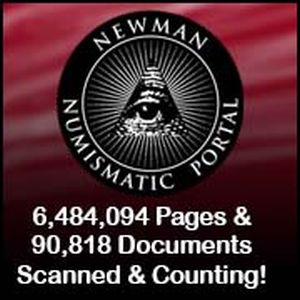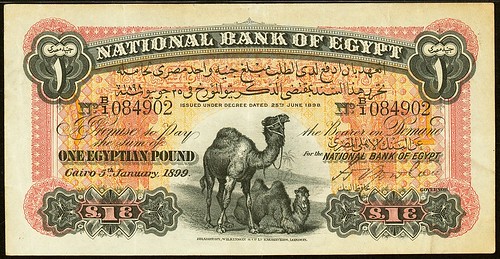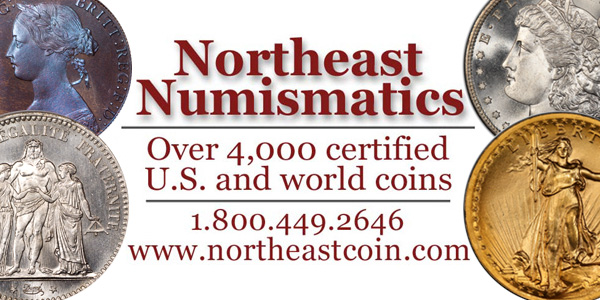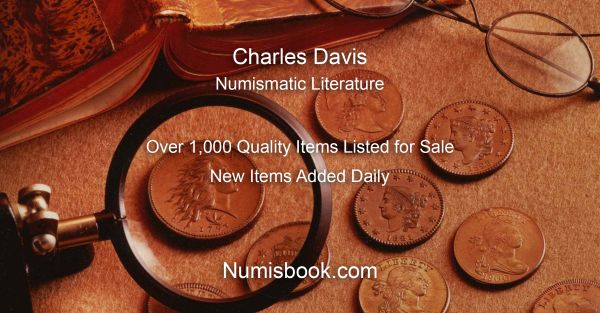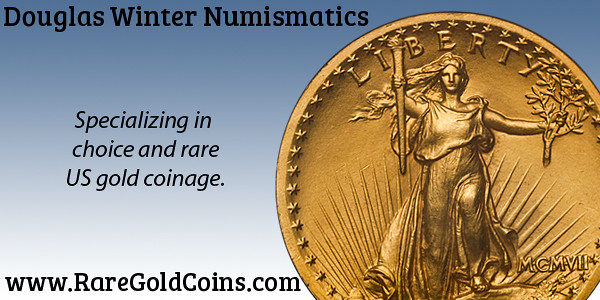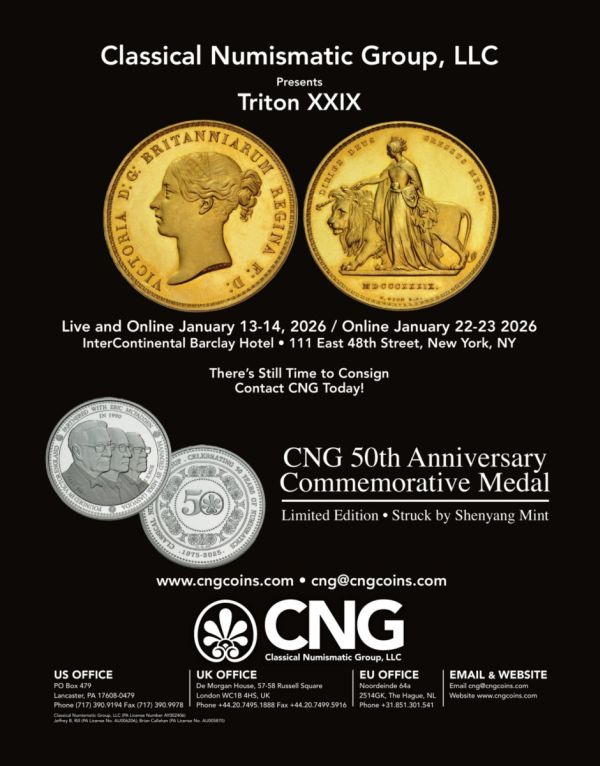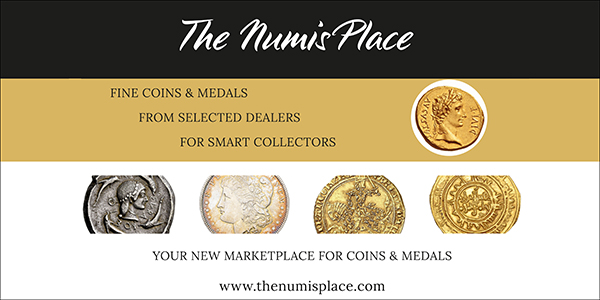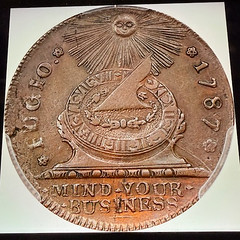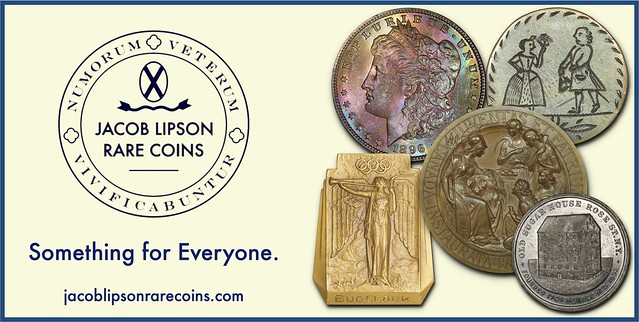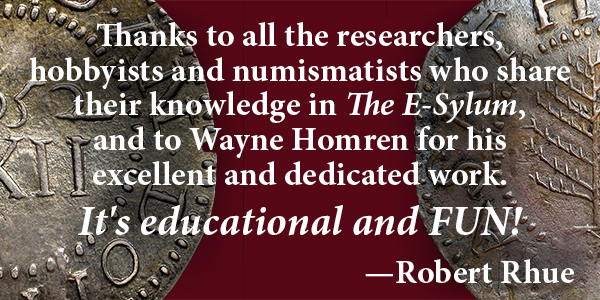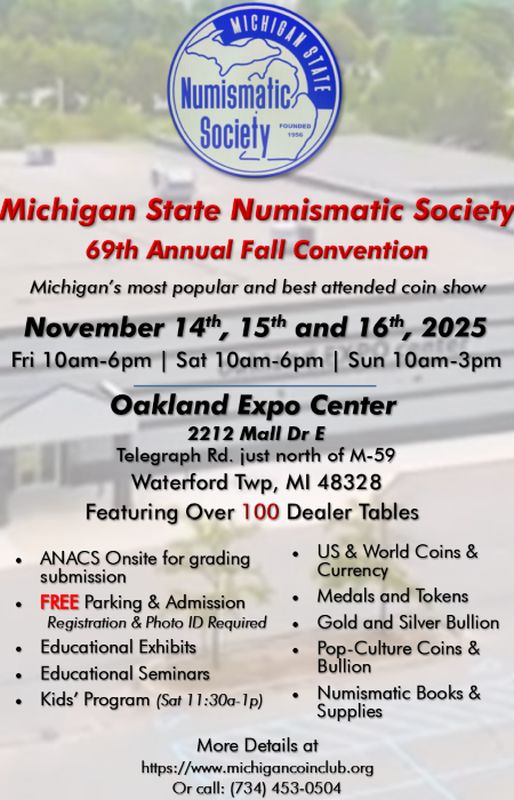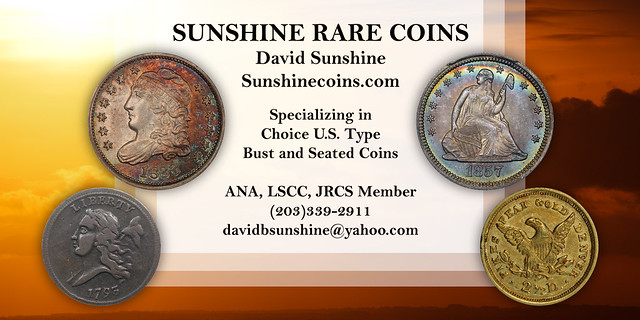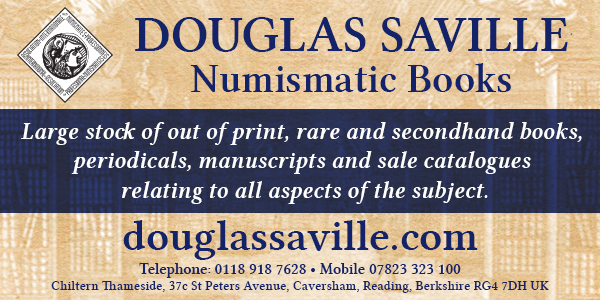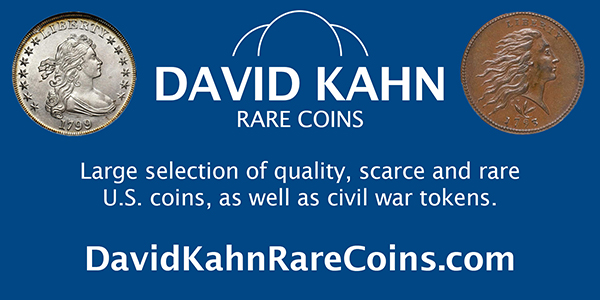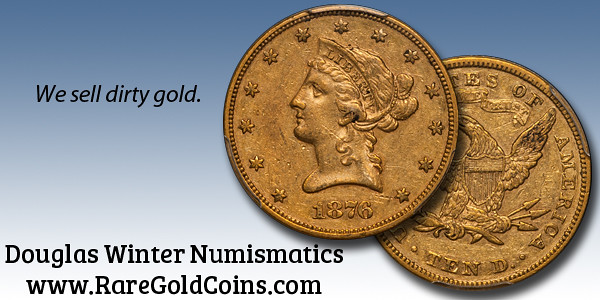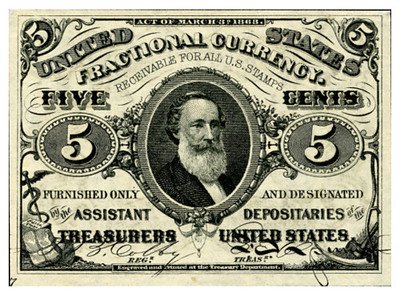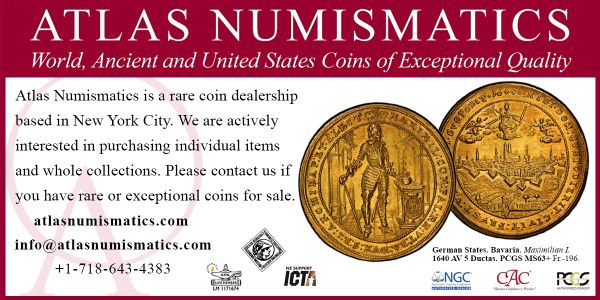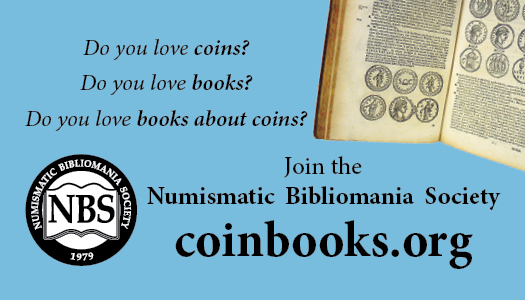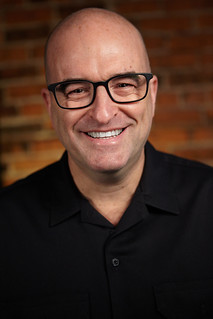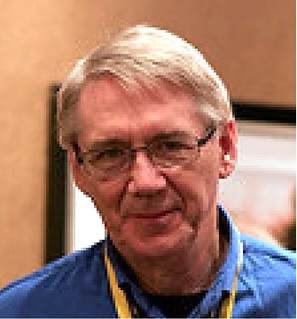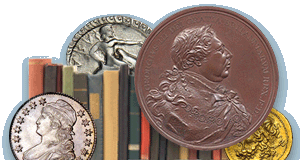
Visit our NBS Sponsors
About UsThe Numismatic Bibliomania Society is a non-profit association devoted to the study and enjoyment of numismatic literature. For more information please see our web site at coinbooks.org SubscriptionsThose wishing to become new E-Sylum subscribers can go to the following web page
Subscribe
MembershipThere is a membership application available on the web site Membership Application To join, print the application and return it with your check to the address printed on the application. Print/Digital membership is $40 to addresses in the U.S., and $60 elsewhere. A digital-only membership is available for $25. For those without web access, write to: Jeff Dickerson, Treasurer AsylumFor Asylum mailing address changes and other membership questions, contact Jeff at this email address: treasurer@coinbooks.org SubmissionsTo submit items for publication in The E-Sylum, write to the Editor at this address: whomren@gmail.com BUY THE BOOK BEFORE THE COINSale Calendar |
- WAYNE'S WORDS: THE E-SYLUM OCTOBER 12, 2025
- KOLBE & FANNING WEB SALE NUMBER 5
- THE 2025 NBS SYMPOSIUM
- NEW BOOK: CENTS AND HALF CENTS OF MASSACHUSETTS
- NEW BOOK: INDIAN PEACE MEDALS AT ANS
- NEW BOOKS: U.S. LARGE CENTS, 2ND EDITION
- NEW BOOK: TREASURES OF THE OCCULT
- PERIODICAL: TAMS JOURNAL SEP-OCT 2025
- NEWMAN PORTAL SCANS LINCOLN SENSE
- VIDEO: LOOKING AT A DOLLAR BILL
- NOTES FROM E-SYLUM READERS: OCTOBER 12, 2025
- THE ARTS OF MONEY: ADOLPH WEINMAN
- CONECA TO OFFER ERROR & VARIETY EXAMINATION
- ERROR COIN PUBLICATION GALLERY
- VOCABULARY TERM: ROTATED DIE
- MORE 1804 DOLLAR STORIES
- 1804 DOLLAR FAKES AND REPLICAS
- 1804 DOLLAR OFFERED ON EBAY
- U.S. MINT 1804 DOLLAR IN GOLD
- SBG RICHARD AUGUST COLONIAL CURRENCY SELECTIONS
- THE DEAN OAKES COLLECTION, PART ONE
- HERITAGE: OCTOBER 2025 WORLD PAPER MONEY
- FRED HOLABIRD'S GRAND FINALE AUCTION
- LIVING AMERICANS ON US COINS
- THE FIRST LIVING PERSON ON A ROMAN COIN
- WOULD THE 2026 TRUMP COIN BE LEGAL?
- PHILIPPINE ABACA FIBER FOR CURRENCY?
- THE 2025 GOLD RUSH
- PAUL KRUGER'S NUMISMATIC LEGACY
- LOOSE CHANGE: OCTOBER 12, 2025
- ABOUT THIS ISSUE: OCTOBER 12, 2025
Content presented in The E-Sylum is not necessarily researched or independently fact-checked, and views expressed do not necessarily represent those of the Numismatic Bibliomania Society.
WAYNE'S WORDS: THE E-SYLUM OCTOBER 12, 2025
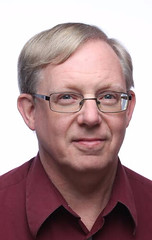 Thank you for reading The E-Sylum. If you enjoy it, please send me the email addresses of friends you think may enjoy it as well and I'll send them a subscription. Contact me at whomren@gmail.com anytime regarding your subscription, or questions, comments or suggestions about our content.
Thank you for reading The E-Sylum. If you enjoy it, please send me the email addresses of friends you think may enjoy it as well and I'll send them a subscription. Contact me at whomren@gmail.com anytime regarding your subscription, or questions, comments or suggestions about our content.
This week we open with a numismatic literature sale, the NBS Symposium, six new books, a periodical, updates from the Newman Numismatic Portal, and more.
Other topics this week include Indian Peace medals, Lincoln Cents, Adolph Weinman, error coins, rotated dies, 1804 dollar stories, fakes and replicas, paper money sale selections, the first living person on a Roman coin, the 2025 gold rush, and Paul Kruger's numismatic legacy.
To learn more about the origin of Whitman Publishing, the Massachusetts Copper Mint, history's unorthodox money, American Token manufacturers, symbology of the U.S. dollar bill, uncut sheet pranksters, the Arts of Money lecture series, the 1804 dollar in gold, the Dean Oakes Collection of U.S. Type Notes, Fred Holabird's Grand Finale auction, living Americans on U.S. coinage, and Philippine abaca fiber, read on. Have a great week, everyone!
Wayne Homren
Editor, The E-Sylum
KOLBE & FANNING WEB SALE NUMBER 5
Numismatic Booksellers Kolbe & Fanning have announced a new web sale on Wednesday, October 22, 2025. Here's the announcement. -Editor
We will be holding Web Sale #5 of Numismatic Books on Wednesday, October 22, starting at 12:00 PM Eastern. This sale focuses on inexpensive but useful books, catalogues and other publications on coins from all times and places. It will take place live online, in much the same format as our Premier Auctions, and all lots in the Web Sale will begin at a very low $10 opening bid.
Bidders may register for the sale, browse lots, and place absentee bids beginning immediately at bid.numislit.com.
Register early to bid online
Kolbe & Fanning use Auction Mobility as our third-party online bidding platform, which is separate from our retail site. Auction Mobility is an app-based platform allowing users the ability to participate in the sale through phones, tablets and computers. To register for the sale, bidders must go to
bid.numislit.com and sign up. Once you have set up an account, you may browse lots, place advance bids, or participate in the live sale online. Those wishing to participate on their devices can download the Kolbe & Fanning app through the Apple or Google Play Store.
Kolbe & Fanning Numismatic Booksellers LLC is a licensed and bonded auction firm in the State of Ohio, and our sales are conducted by licensed auctioneers. For more information, please see the Kolbe & Fanning website at numislit.com or email David Fanning at df@numislit.com. To register for the sale, go to bid.numislit.com. We look forward to your participation.
THE 2025 NBS SYMPOSIUM
The 2025 NBS Symposium took place at the American Numismatic Association convention in Oklahoma City, on Thursday, August 21, at 1PM. This year's event featured Jeff Garrett (shown below) speaking on the Guide Book of U.S. Coins, for which he is the Senior Editor. Numismatic Bibliomania Society President Len Augsburger submitted this report. Thank you. -Editor
 The corporate origins of Whitman Publishing, the current owner of the Guide Book,
begin in 1907, as West Side Printing in Racine, WI. The company's name was changed
to Western Printing & Lithography in 1910, and the firm found a foothold in the
children's book business. The more familiar Whitman Publishing brand, technically a
subsidiary of Western Printing, was launched in 1916.
The corporate origins of Whitman Publishing, the current owner of the Guide Book,
begin in 1907, as West Side Printing in Racine, WI. The company's name was changed
to Western Printing & Lithography in 1910, and the firm found a foothold in the
children's book business. The more familiar Whitman Publishing brand, technically a
subsidiary of Western Printing, was launched in 1916.
In addition to books, the company developed die cutting capability and produced board games, playing cards, and eventually coin boards. Sometime in the mid-1930s Whitman acquired the rights to the coin board as invented by Joseph Kent Post, and the rest, as they say, is history. Garrett noted that the soon-to-be ubiquitous coin board democratized coin collecting and opened the "hobby of kings" to the general public. Jeff himself was introduced to coin collecting via the Whitman folder, in 1969.
Richard Yeo, aka R. S. Yeoman, joined Whitman in 1932 and took charge of the coin board business. Soon the audience consisted of millions of coin collectors, but with little published information to guide them. J. W. Scott, B. Max Mehl, and others, took furtive steps towards creating catalogs and price guides, but none of these gained a mass following. While Mehl's Star Rare Coin Encyclopedia sold well, it remained a "prices paid for" list rather than an authoritative and concise reference.
Whitman first published the "Blue Book" in 1942 as a wholesale guide. Garrett acknowledges Yeoman's foresight in creating the "contributor system," which relied on a large group of numismatic experts (Lee Hewitt, Charles Green, etc.) rather than a single author.
The Guide Book, more popularly known as the "Red Book," was envisioned in the early 1940s but postponed by World War II. Yeoman reflected that the delay ended up being positive in the sense that it provided additional time to develop the concept. Early contributors included Stuart Mosher, Audrey Bebee, Abner Kreisberg, Abe Kosoff, and others. The first printing of 9,000 copies was in 1946, with a 1947 cover date. After selling out, a second printing of the same edition was produced with a similar press run.
The coin business grew substantially in the 1950s and 1960s, and by 1971, Whitman had produced over ten million copies of the Guide Book. Subsequently, Guide Book sales tracked with overall interest in coin collecting. To date, over 25 million copies have been sold. Current sales are on the order of a quarter million copies annually.
About 20 years ago, Whitman approached Garrett about joining the Guide Book editorial team. Garrett first worked on gold coin pricing, having previously published the Encyclopedia of U.S. Gold Coins 1795-1933, with co-author Ron Guth, in 2008. By around 2015, Garrett was overseeing all areas of pricing for the Guide Book. Garrett's background as a dealer in multiple areas of U.S. numismatics served well for this task. During this time the technology for developing pricing evolved from index cards to Excel spreadsheets, although not all the Guide Book contributors were similarly versed in Excel.
With the launch of the "Mega-Red," a greatly expanded edition first published in 2015, Garrett's responsibilities greatly increased, with editorial and pricing work now covering over 8,000 specific issues, including many varieties not listed in the regular Guide Book. This book contained both pricing and expanded editorial content for specialty issues, with substantial contributions from Q. David Bowers. Jeff is currently working on the next "Mega-Red," which will appear in 2026.
Garrett reflected on Ken Bressett's work for Whitman. Ken consulted on the Guide Book before moving to Wisconsin in 1959 when he joined the company full-time. In 1962, Bressett was a co-author, with Eric P. Newman, of The Fantastic 1804 Dollar. Garrett noted that Bressett remained just as fascinated with the coin today and was especially interested in the discovery of the 16th example, which was recently announced by Stack's Bowers. Garrett presented Bressett as a candidate for "the world's most interesting man." Who else dove with Mel Fisher at the Atocha site, as a numismatic authority appointed by a lending bank to appraise the find?
Garrett noted that his first ANA summer seminar, in 1974, was taught by Bressett. Ken developed the ANA grading standards and was elected to the ANA Hall of Fame in 1986. In 1996 he joined the Citizens Coinage Advisory Committee and played an important role in the development of the States Quarters program, which was launched in 1999.
Jeff talked about the transition of Whitman Publishing to new ownership, as CDN acquired the company from Anderson Press in 2023. For many years, Whitman was reluctant to make major changes to the Guide Book, as the brand was exceptionally strong and remained a solid seller. This was compounded by a responsibility to "get this book right" as it is the "gateway" for new collectors. Not only is this the entry point, but the Guide Book remains a constantly consulted reference even among advanced collectors.
Charles Anderson approached John Feigenbaum at CDN about acquiring Whitman and held the matter in such confidence that even Garrett was unaware until the transaction was finalized. Garrett viewed the sale as an opportunity to evolve the Red Book brand and welcomed Feigenbaum as an "innovator" willing to "take risks." Jeff noted John's earlier acquisition of the Greysheet and its subsequent migration to a digital platform.
The Red Book is now slightly larger and reflects a more common size format in the book publishing industry. Jeff did ask John to maintain the red color cover! But the more substantial change is on the back end, as the Guide Book now leverages the CDN coin pricing database. Much of this is based on auction records. Jeff no longer spends time on pricing and instead has a role more focused on editorial content. In this capacity, he asks himself "How do collectors collect?" and "What information do they need to enable that pursuit?" Jeff found his previous pricing work sometimes tedious and enjoys this new role.
Jeff points to changes such as the introduction of a photographic grading guide, information on die variety attribution aimed as beginners, and a streamlined section on U.S. commemoratives, in response to the abundance of U.S. Mint product in recent years. For American silver eagles, MS70 pricing is now added, simply because that is how many collectors approach the series.
While editorial content evolves, pricing remains the core of the Guide Book. Jeff covered historical resources for pricing, including old edition of the Greysheet and the David Akers series of books on U.S. gold. Garrett maintains an extensive collection of auction catalogs and remains drawn to the physical format even while acknowledging resources such as Newman Portal.
Jeff is constantly asked for prices on rare coins and notes the challenge of pricing in a collector market as opposed to an investor market, which held sway a generation ago. Today's collectors are more focused on eye appeal, a subjective measure that can be difficult to evaluate. So, how do you produce a single price for all examples of a single issue in a given grade?
Garrett notes that the Red Book price represents the imaginary, average coin for each grade. This is a coin that is not high or low-end for the grade, but simply average. For wholesale vs. retail pricing, Garrett notes that levels will be closer for commodity-type items (an 1881-S Morgan dollar in MS65) and wider for rare issues that appear only infrequently (an 1892-S Morgan in MS63). Garrett appreciates the current transparency of U.S. rare coin market pricing and refers to resources such as the Heritage Auctions archive, which includes over seven million records across all categories.
Still, pricing can remain an art, especially for coins that are infrequently traded or examples with exceptionally eye appeal. Certification levels also play a role, with CAC drawing significant attention in the last few years. And for unique or "finest known" items, only an auction can reveal the true value of a coin. Jeff notes a 1938-S MS68+ Mercury dime sold by Legend Auctions in 2019 for $364,250 "because two people went to mortal combat to buy it [based on] a pop report." As a result, the Guide Book sometimes simply publishes the last known auction price for especially rare items.
Garrett concluded by noting that the current environment supplies more information than ever to prospective collectors and believes that this will continue to fuel the overall numismatic market. The NBS recognized Garrett with a speaker's plaque in appreciation for this Symposium presentation.
To watch the complete video, see:
NBS Symposium (ANA 2025)
(https://www.youtube.com/watch?v=JspyXpxmIjs)
Numismatic Bibliomania Society Symposium 2025 ANA
(https://nnp.wustl.edu/library/book/650557)
NEW BOOK: CENTS AND HALF CENTS OF MASSACHUSETTS
Mike Packard's book on the Massachusetts coppers has been published. Kolbe & Fanning Booksellers calls it "long-awaited" in the numismatic understatement of the century - collectors have been waiting since 1920 for a new book on the topic, and there's no one better to write it - Mike has been studying and collecting these for decades. Congratulations! Orders may be placed with either Kolbe & Fanning Numismatic Booksellers (https:www.numislit.com) or Charles Davis Numismatic Literature (https:www.numisbook.com). -Editor
 THE CENTS AND HALF CENTS OF MASSACHUSETTS
THE CENTS AND HALF CENTS OF MASSACHUSETTS
Packard, Michael
2025. 310 pages, illustrated.
The long-awaited standard reference to the Massachusetts copper coinage of 1787–1788, providing detailed historical background as well as a carefully written and well-illustrated attribution guide to the die varieties of the series. The first major study of these coins since Hillyer Ryder's "The Copper Coins of Massachusetts" was published in 1920.
Here's the book's Introduction. -Editor
Massachusetts coppers—cents and half cents—are the least appreciated of the coins authorized and struck by four states during the Confederation period. This is surprising because the Massachusetts coppers were the best-produced of the state coins. Their weights were the most consistent, their planchets were the best quality, they had the fewest striking errors, and their mintage of less than half a million pieces was probably the lowest of the state coppers. In addition, they were the first coins to bear the words "CENT" and "HALF CENT." What's not to like?
A common complaint about the series is that the varieties look too much alike and are too hard to differentiate from each other. However, one doesn't have to be a variety collector to enjoy holding an example of the first cent or half cent ever produced. These are historic coins. If one wants to collect a variety set, one must be patient. Almost a quarter of the varieties are known by fewer than two dozen examples. Hopefully, this book will resolve the variety identification problem and bring a few more examples of the scarcer varieties to light.
Although many people who buy this book will do so for the attribution guide, the history of the Massachusetts Copper Mint and how it came to be is interesting in its own right. Commerce in most, if not all states during that period suffered for lack of an adequate amount of specie. From the beginning of the revolution, there were calls for the new federal government to open a mint and strike coins for circulation. Always there were delays. Finally in mid-1785, Vermont, an independent republic and not yet a state, began coining its own money. Three other states subsequently followed suit. Massachusetts was the last state to pass an act to establish a mint. It did so in October 1786, unaware that Congress had passed a similar act to establish a federal mint just the day before.
No mint-related work was conducted in Massachusetts until after Congress decided in April 1787 to contract for coinage instead of opening a national mint. Work on the new mint began, but even then, it was slow. The first Massachusetts cents and half cents were not struck until September 1787. Many of those first coins were not retained and used within the Commonwealth. They were placed aboard two ships that set sail on an historic voyage of adventure.
Minting was slow, output was low, and the staff was let go. The legislature intended to replace the mintmaster and his crew with someone they hoped would do a better job. However, the new Constitution gave the federal government the sole right to coin money and expressly forbade the states from doing so. The Massachusetts Mint closed in January 1789. Seven weeks later, the Constitution took effect when the first Congress was seated. The mintmaster got his revenge, though. His final accounting indicated he was owed a large sum, more than all the money coined under his watch. And he was paid!
For more information, or to order, see:
https://www.numisbook.com/
THE CENTS AND HALF CENTS OF MASSACHUSETTS
(https://www.numislit.com/pages/books/7738/michael-packard/the-cents-and-half-cents-of-massachusetts)
NEW BOOK: INDIAN PEACE MEDALS AT ANS
The ANS has published a new catalogue of their Indian Peace Medal collection, written by Oliver Hoover. -Editor
 The American Numismatic Society is pleased to announce the release of an exciting new book in our Studies in Medallic Art series: "Let Us Have Peace" A Catalogue of Indian Peace Medals at the American Numismatic Society.
The American Numismatic Society is pleased to announce the release of an exciting new book in our Studies in Medallic Art series: "Let Us Have Peace" A Catalogue of Indian Peace Medals at the American Numismatic Society.
With 535 pages, including more than 600 images printed in full color, Let Us Have Peace offers a detailed numismatic, art- and socio-historical discussion of 302 Indian peace medals and related objects that entered the cabinet of the American Numismatic Society between 1883 and 2018. The medals represent an important and often under-utilized resource for the history of relationships between the Native peoples of North America and the colonial powers of France, Great Britain, and Spain, as well as their successors, Canada and the United States of America. Despite being inanimate objects of silver and copper, the Indian peace medals in the ANS collection are incomparable storytellers, each offering its own tale of the past that gives us insight into the remarkable lives of the medals' creators, distributors, and recipients.
Publication of this book has been made possible by the generous support of Kenneth L. Edlow and Stack's Bowers Galleries.
For any questions about the book please contact publications@numismatics.org, though orders should be placed directly with ISD for any US-based purchasers or Brepols for those living outside of the United States. ANS members are eligible for a 30% discount on this title and all other ANS publications.
Let Us Have Peace
A Catalogue of Indian Peace Medals at the American Numismatic Society
Oliver D. Hoover
Pages: ix + 535 p.
Size:216 x 280 mm
Illustrations:600 col.
Language(s):English
Publication Year:2025
ISBN: 978-0-89722-392-8
Hardback
For more information, or to order, see:
'Let Us Have Peace'
A Catalogue of Indian Peace Medals at the American Numismatic Society
(https://www.isdistribution.com/BookDetail.aspx?aId=189159)
Let Us Have Peace
A Catalogue of Indian Peace Medals at the American Numismatic Society
(https://www.brepols.net/products/IS-9780897223928-1)
NEW BOOKS: U.S. LARGE CENTS, 2ND EDITION
Robert Powers has completed the 2nd Edition of his Early Large Cent book, newly expanded, much improved, and now called the Professional Edition. It is available in three volumes: 1793-1795; 1796-1799; 1800-1814, and available from David Kahn Rare Coins, Inc. -Editor
This is the follow-up publication to the author's 2020 publication, U.S. Large Cents 1793-1814 Variety Identification Guide (the "blue book"). This is the first of three new volumes which are designed in the same familiar format, though with important updates, greatly improved photos, and much more.
This guide is entitled the Professional Edition as it is primarily targeted at users who already have (or aspire to have) an intermediate or advanced level of expertise in attributing Early Date Large Cents, or who have expertise in other series and want to take their underlying knowledge of attribution methods from elsewhere into this series.
The author of this guide is not a fan of "change for the sake of change." As such, he has kept the guide in the same intuitive format, while at the same time introducing important and highly useful new features, as well as important updates and previous omissions included.
One difference in this guide and the previous 2020 guide is that the text descriptions of each die is more succinct, focusing on the unique reminders the distinguish each die, rather than extended dialogue that covers the same ground that you should already know to be using with your attributions, such as letter, leaf, and date positions. This is not to say that the latter observations are not mentioned when it feels needed, but the dialogue surrounding such observations is cut to a minimum to reduce clutter.
In addition, this guide contains markedly improved photos, dozens upon dozens of all new close-up photos, lots of pickup points not necessarily covered in the first guide, and last but certainly not least, a proprietary die staging and pricing system not found anywhere else.
The die staging system is fairly self-explanatory. It uses a decimal system, very similar to the die staging system used with Bust Half Dimes, and even somewhat similar to the new die staging system published in the Bust Half Nut Club's new book. In this guide, you will find the description of the respective die stage described for the obverse and reverse. For the purposes of attribution, whichever side of the coin is more advanced is in fact the overall die stage (ie- the more advanced side supersedes the other side).
The unique pricing system contained in this guide is very similar to the unique pricing system used in the author's previous publication from 2024, the U.S Coin Die Varieties guide. Instead of giving actual dollar amounts for the price in any particular grade for a given marriage, the value is given in relative terms in comparison to the most common (least valuable) underlying sub-type for the year (the 1794 head of 94's will be compared to the most common 1794 head of 94's, but not the Head of 93's, for example). The whole purpose for not giving specific dollar amounts is so that the price guide will stand up to the test of time much more resiliently than with specific numbers.
For more information, or to order, see:
U.S. Large Cents 1793 – 1795 Variety Identification And Pricing Guide (Pro Edition), by Robert Powers
(https://davidkahnrarecoins.com/product/u-s-large-cents-1793-1795-variety-identification-and-pricing-guide-pro-edition-by-robert-powers/)
U.S. Large Cents 1796 – 1799 Variety Identification And Pricing Guide (Pro Edition), by Robert Powers
(https://davidkahnrarecoins.com/product/u-s-large-cents-1796-1799-variety-identification-and-pricing-guide-pro-edition-by-robert-powers/)
U.S. Large Cents 1800 – 1814 Variety Identification And Pricing Guide (Pro Edition), by Robert Powers
(https://davidkahnrarecoins.com/product/u-s-large-cents-1800-1814-variety-identification-and-pricing-guide-pro-edition-by-robert-powers/)
NEW BOOK: TREASURES OF THE OCCULT
Baldwin's Head of Ancient Coins Dominic Chorney has published a book embracing weird, magic and occult themes in numismatics. Here's information from the publisher's website. -Editor
 Step into the realm of mysterious money in Dominic Chorney's latest publication: Treasures of the Occult. When you're done with this book, you might never look at the coins in your pocket the same way again.
Step into the realm of mysterious money in Dominic Chorney's latest publication: Treasures of the Occult. When you're done with this book, you might never look at the coins in your pocket the same way again.
Just in time for Halloween, Treasures of the Occult will be released in October 2025. Only 800 first edition copies will be printed.
The mysteries of the world aren't confined to haunted houses, spooky woods, and dark tunnels. They're everywhere. They even haunt the money we spend. For over 2,000 years, since the beginnings of currency in the ancient world, coins and treasure have been associated with unusual events, frightening creatures and occult magic. For the first time, Treasures of the Occult will take the reader on a journey through the world of unusual coins: treasure magic, secret societies, monsters, UFOs and occult imagery. These are just a few of the many topics explored in the publication, which will be of interest to coin collectors, historians, and ghost hunters alike. Featuring a foreword by Dr. Ciaran O'Keeffe.
- Hand-signed & individually numbered (preorder customers only)
- First Edition
- Limited Edition Hardback
- Only 800 copies printed
- 191 high-quality images. Fully referenced. 230pp.
- £34.95
Images are digital renders. Final version may vary.
About the Author
 Dominic specialises in the ancient world and provides advice on Greek, Roman and Iron Age coinage. He is a graduate of Cardiff University, and the University of Warwick, where he earned a master's degree in Ancient Visual and Material Culture.
Dominic specialises in the ancient world and provides advice on Greek, Roman and Iron Age coinage. He is a graduate of Cardiff University, and the University of Warwick, where he earned a master's degree in Ancient Visual and Material Culture.
Dominic is also an independent treasure valuer for the British Museum.
Reviews
"Magical! What an unusual and entertaining look at coins and tokens across the ages. From monsters to myths to magic, this new book takes numismatists into a new and sometimes bizarre world that they may not have considered before, it's well worth drawing back the veil of mystery to take a peek!"
Phil Mussell, Coin News
"Since the advent of coinage around 26 centuries ago, coins and treasure have been associated with unusual events, like comets, frightening creatures, and magic. I have been a keen coin collector for 60 years, but this is the first publication about the Fortean (fringe science) side of the subject, as far as I am aware. An elegant and informative book that should appeal to fans of mystery and symbolism."
Paul Sieveking, Fortean Times Magazine
For more information, or to order, see:
Treasures of the Occult – New Book!
(https://www.baldwin.co.uk/product/treasures-of-the-occult-pre-order/)

For a taste of the book's topics, see some of Dominic's blog posts. And check out the Treasures of the Occult Tote Bag. -Editor
To read the complete articles, see:
Medusa's Gaze: How Magic Protected Ancient Currency
(https://www.completecollector.co.uk/complete-collector/medusas-gaze-how-magic-protected-ancient-currency)
Top 10 Spooky Coins Throughout History: Witchcraft, Skulls, and UFOs
(https://www.completecollector.co.uk/complete-collector/top-10-spooky-coins)
Or order the tote bag, see:
Tote Bag: Treasures of the Occult
(https://www.baldwin.co.uk/product/treasures-of-the-occult-tote-bags/)
PERIODICAL: TAMS JOURNAL SEP-OCT 2025
The September-October issue of The TAMS Journal has been published by the Token and Medal Society. If you have even the slightest interest in the topics, you need to be a member. See the link below for more information. -Editor
Table of Contents
The Calvin Coolidge Inaugural Medal
Harry Waterson
Philip Whitlock and His Old Virginia Cheroots
David E. Schenkman
The Home Insurance Company, New York; Counting the Years
Harry Waterson
Columns
From the President
James Brokamp
Fingers on the Keyboard
Greg Burns
This & That
Harry Waterson
Mavericks
Ryan Kordziel
American Token Manufacturers & Their Agents
David E. Schenkman
Counterstamp Corner
Greg Bennick
So-Called Dollar Stories
Jeff Shevlin
Sixty Years Ago in TAMS
Greg Burns
Society News and Reports
Secretary's Report
Donna Moon
General News/Pleas
TAMS Report from OKC
Letters
From the Bookshelf
Peter Irion
Farewells
Here's an excerpt from President James Brokamp's column with a report from the Oklahoma City ANA convention. -Editor
Wednesday afternoon's TAMS regular membership meeting featured Greg Bennick's fascinating presentation on counterstamped coins. He held the crowd's attention with lots of examples and the unique stories that they hold. Upon wrapping-up, the attendees had plenty of questions, and I'm guessing Greg baptized some new converts to that segment of our hobby. Good job, Greg! Look for his column "Counterstamp Corner" in each issue of the journal.
Before dispersing, the crowd was treated to a unique (and whimsical) musical performance by Bob Evans and Fred Holabird. Who knew that these two are musically gifted as well? Good stuff, fella's!
Wednesday evening saw us all gather at the Cattlemen's Steakhouse for the annual TAMS Banquet. Once again, Donna Moon orchestrated a wonderful night of fellowship, recognition, fund raising ($2,500+), and some seriously frivolous fun!
The Dave and Fred Show (Schenkman & Holabird) kept the festivities rolling with lighthearted laughter, and many generous donations were bid on and won by attendees! Yours truly even bought a TAMS beret….you know, for those chilly Ohio winters! LOL!
I felt compelled to recognize several members this time around with the President's Award. Each recipient has provided me with exceptional support and advice over the past year. Congratulations to Larry Baber, Kathy Freeland, Rick Gaetano, and Donna Moon!
For more information of the Token and Medal Society (TAMS), see:
https://www.tokenandmedal.org/
THE BOOK BAZARRE
NEWMAN PORTAL SCANS LINCOLN SENSE
The latest addition to the Newman Numismatic Portal is Lincoln Sense from the Society of Lincoln Cent Collectors. Project Coordinator Len Augsburger provided the following report. -Editor
Newman Portal Scans Lincoln Sense
 With assistance from Gary Rosner and Chuck Daughtrey, Newman Portal has digitized a run of Lincoln Sense, the newsletter of the Society of Lincoln Cent Collectors (SLCC), covering the years from 1996 to 2007. The SLCC was formed in 1982 by Dr. Sol Taylor, who for many years acted as president and editor. In later years, Chuck Daughtrey served the organization.
With assistance from Gary Rosner and Chuck Daughtrey, Newman Portal has digitized a run of Lincoln Sense, the newsletter of the Society of Lincoln Cent Collectors (SLCC), covering the years from 1996 to 2007. The SLCC was formed in 1982 by Dr. Sol Taylor, who for many years acted as president and editor. In later years, Chuck Daughtrey served the organization.
While Lincoln Sense provided liberal coverage of commercial matters such as pricing and grading, the newsletter also included articles on new discoveries and research. Occasional tidbits such as a 1981 handwritten letter from Stewart Blay (April 2005 issue), who formed the ne plus ultra Lincoln cent collection, are present. The September 1998 issue reprinted U.S. Mint correspondence related to Victor D. Brenner, the Lincoln cent designer, this material contributed by Carl Waltz.
Link to Lincoln Sense on Newman Portal:
https://nnp.wustl.edu/library/publisherdetail/557176
VIDEO: LOOKING AT A DOLLAR BILL
The David Lisot Video Library on the Newman Numismatic Portal can be found at:
https://nnp.wustl.edu/library/multimediadetail/522852
We highlight one of his videos each week in The E-Sylum. Here's one from 2009 with Carl Schwenker speaking about the symbology of the U.S. dollar bill. -Editor
Who ever looks at a dollar bill? Besides George Washington's obvious portrait you may be intrigued by all the other imagery. Learn what these mean including the Great Pyramid, the "all seeing eye", the heraldic eagle and much more. Included in this presentation is a touching tribute by presenter Carl Schwenker to fellow numismatist and friend Francis Townsend who recently passed away.
Speaker: Carl Schwenker. December 15, 2009.
To watch the complete video, see:
Have You Ever Really Looked at a Dollar Bill?
(https://youtu.be/CQ90sZDoO7s)
Have You Ever Really Looked at a Dollar Bill?
(https://nnp.wustl.edu/library/book/549087)
NOTES FROM E-SYLUM READERS: OCTOBER 12, 2025
Stolen Fugio
Tony Terranova reported that this Fugio was stolen in the USPS between Florida and New York, and should be identifiable by the surface defects. Please keep an eye out! -Editor
South Africa Coin Comments Sought
Website visitor Shaun Thomson of South Africa writes:
"I have a 2010 50 cent coin. On the year of minting side of the coin, you will see that the year 2010 reads "201 0". There is a gap between the 1 and the 0. On the other side of the coin, at the top of the 5 in the 50, there is an extra piece on the 5. I have attached pictures of the coin. Please send me your opinion and if there is any value to this coin."
I see what he means but have no knowledge of this coin and can't assist. But I offered to put this to our readers. Thoughts, anyone? The "5" seems like a normal digit to me, but that date spacing is odd. Shaun can be reached at shaungthomson@gmail.com . Examples pictured on Numista and other online platforms show the same features. -Editor
To read the complete Numista entry, see:
50 Cents Afrika-Dzonga
(https://en.numista.com/28244)
Two Weird Cents
Wayne Pearson's niece Mara found this while working at Goodwill and he asked me what I thought of it. -Editor
This looked like post-mint damage to me, not a mint error. But I'm new to error collecting, and only collect off-centers. So I reached out to our error expert friend, Greg Bennick of The Combined Organization of Numismatic Error Collectors of America (CONECA). He agreed and quickly replied "Damaged!" Online bidders disagreed, and the coin raised $52 for Goodwill.
Below is another cent Mara asked about, which also looks like post-mint damage. Both coins are interesting, showing damage not seen with typical circulation - someone likely played around with these. What do readers think? Has anyone seen coins like these? -Editor
To read the complete lot description, see:
1pc US 1996 ERROR Broadstrike Penny One Cent Denver Mint - Raised Edges
(https://shopgoodwill.com/item/242975576)
1680 German Coinage Proclamation
Another item I've been sitting on for a while is this interesting 1680 German proclamation on no good, very bad, perfectly awful coinage sent in by Patrick Parkinson. Thanks. Here's an image and seller link with a Google translation of the seller's description. -Editor
After a noble, strict, prudent, and highly wise councilor of this city received thorough information that a large number of prohibited, excessively rich, and not better types of coins had been brought here these days under the authority of Lord Augustus Frederick, Bishop of Lübeck, and Duke of Holstein, etc., as well as Lord Carl Wilhelm, Prince of Anhalt, by decree in the Senate on March 6, 1680.
To read the complete item description, see:
[NUMISMATICS / CURRENCY REGULATIONS ~ 1680].
(https://www.abebooks.com/NUMISMATICS-CURRENCY-REGULATIONS-1680-Nachdeme-Wohl-Edlen/32296940113/bd)
1893 Columbian Exposition Designer Medal
Jim Haas sent in this image of a medal I don't think I've seen before. Thanks. It's been buried in my email since July, but I guess the universe wanted it to resurface in time for Columbus Day. A Google image search helped me locate an article discussing these medals on the NGC site. There's no byline, but it was probably authored by the late Dave Lange. -Editor
To read the complete NGC article, see:
NGC Certifies Rare Gold Medal Awarded to Columbian Expo Officer
(https://www.ngccoin.com/news/article/7331/Columbian-expo-medal/)
Uncut Sheet Pranksters
Back in August
Donn Pearlman wrote:
"A few decades ago when I was working with ANA PR Director Steve Bobbitt to promote ANA conventions, we made arrangements in one city with a popular coffeehouse to have a TV station videotape Steve as he purchased a $3 cup of coffee.
"The cashier did not know in advance that Steve would pull out an uncut sheet of 32 $1 notes and use scissors to cut off a block of three notes, which he handed to the bewildered cashier.
"I was cordially asked by the BEP if we could not do that again, as it might give the public the wrong idea about uncut sheets."
Funny. Apple cofounder Steve Wozniak was also an uncut sheet prankster. -Editor
To read the earlier E-Sylum articles, see:
UNCUT SHEET PRANKS
(https://coinbooks.org/esylum_v07n24a14.html)
MORE UNCUT SHEET TALES
(https://www.coinbooks.org/esylum_v07n25a19.html)
STEVE WOZNIAK'S PERFORATED PADS OF $2 BILLS
(https://www.coinbooks.org/esylum_v18n36a40.html)
Another Trump Overstamp
Paul Horner writes:
"I got this series 2009 $20 in change at the Raleigh Coin Show. Fits in nicely with your previous versions."
Paul sent me this over the summer just after the show, but it got buried in a pile of email I'm just now sorting through. Thanks. I haven't run across political message stamps on notes, although I did come across a "Where's George" note a few weeks ago. -Editor
To read the earlier E-Sylum article, see:
MORE ON POLITICAL SLOGANS ON BANKNOTES
(https://www.coinbooks.org/v21/esylum_v21n21a16.html)
Another "Where's George"
I haven't had time to mention this before either, but I recently came across this dollar bill with a "Where's George" stamp on the left margin. It had been so long since I'd seen one I wondered if the website was still around. It is, and my old login still works.
The bill had only been entered for the first time on June 20, 2025 in Lutherville-Timonium, Maryland. I work in Maryland but don't recall if I got the note up there or down here in Virginia. I'll put it back in my wallet and spend it again. -Editor
Have any of our readers been finding and entering "Where's George" notes lately? -Editor
For the Where's George? Bill Tracking Report, see:
Where's George? Bill Tracking Report
(https://www.wheresgeorge.com/b:IbznZPaikZ)
THE ARTS OF MONEY: ADOLPH WEINMAN
Carlos Kearns submitted this announcement of the latest lecture in the Arts of Money series. Great forum! -Editor
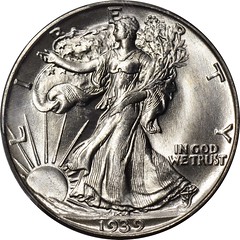 The Pennsylvania Association Of Numismatists (PAN), The American Numismatic Society (ANS) and the National Arts Club (NAC) bring together this important program to showcase the interaction between Numismatics and the Arts. Former President of the American Numismatic Association, Tom Uram and PAN Vice President Carlos Kearns (also member of the NAC) are curating the series. The goal is to bridge the arts and numismatic communities through common understanding of the richness of US coin design.
The Pennsylvania Association Of Numismatists (PAN), The American Numismatic Society (ANS) and the National Arts Club (NAC) bring together this important program to showcase the interaction between Numismatics and the Arts. Former President of the American Numismatic Association, Tom Uram and PAN Vice President Carlos Kearns (also member of the NAC) are curating the series. The goal is to bridge the arts and numismatic communities through common understanding of the richness of US coin design.
Featured this year will be the coins and artistic works of renowned designer and medalist Adolph Weinman, who created the Walking Liberty Half Dollar and Mercury Dime, two of the most beautiful US coins of the 20th century. Weinman was honored for his work by the National Arts Club in 1936. The series will include a presentation by nationally acclaimed numismatist, Dr. Jesse Kraft. An exhibit of his coins and artistic work will accompany the presentation, courtesy of The American Numismatic Society, Constantin and Jocelyn Marinescu, Gary Adkins and Carlos Kearns.
We will honor the work of artists Laura and James Earle Fraser with the Fourth Series in 2026.
PAN thanks the many generous sponsors for the Arts of Money Series this year
- Heritage Auctions
- Dr. Richard Rosenfeld
- Dr. Elizabeth Eelkema - Vorum and the Estate of Daniel F. Vorum.
- Angello Cillia - CF Capital Advisors
- Tony Terranova
- Dr. Constantin Marinescu - Vilmar Numismatics
- Brett Irick
- Chang Bullock - Minted Assets
-
 David Seibert - The Coin Collector
David Seibert - The Coin Collector
- Mary Lannin - New York Numismatic Club
- Richard Jaffe - Westmoreland Rare Coins
- Gary Adkins - Gary Adkins Assoc.
- Blaine Shiff - Cybercoins
Three Levels of sponsorship are available:
- Gold - $5000
- Silver - $3000
- Bronze - $1000
All sponsorships are tax deductible, payable to the PAN Foundation, and can be sent to PAN Foundation, 1985 Lincoln Way, Suite 23 #225, White Oak, PA 15121
For further information: Ckearns@fastmail.fm
CONECA TO OFFER ERROR & VARIETY EXAMINATION
CONECA will be examining error and variety coins for free around the USA in the next few months, including the Pennsylvania Association of Numismatists (PAN) show, the Willamette Coin Club show, and the FUN show. Here is a press release. -Garrett
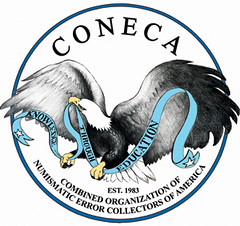 CONECA, the international error coin and variety club, will be offering free examination of error and variety coins to collectors at educational tables at coin shows across the United States throughout this year and into 2026.
CONECA, the international error coin and variety club, will be offering free examination of error and variety coins to collectors at educational tables at coin shows across the United States throughout this year and into 2026.
The club, whose name stands for "Combined Organizations of Numismatic Error Collectors of America," is the largest coin specialty club in the United States and has actively been educating collectors about mint error and variety coins for the last five decades. They would love to help you with your error coins!
At their coin show tables, different members of the CONECA Board of Directors and other error / variety enthusiasts (each with different areas of specialty as available) will offer free examination to collectors who bring coins from their collection to the show with questions. This is offered as a free service to help the hobby grow.
CONECA is devoted to education about errors and varieties and will not be buying or selling coins at their tables. The club requests that collectors have an idea of what they are asking about on the coins they bring to the shows, to allow for as many collectors as possible to have a chance to have their coins examined. The show schedule is as follows…
There will be a CONECA table at the Fall Pennsylvania Association of Numismatists (PAN) show October 16-17-18th, 2025. The show will be held at the Monroeville Convention Center, 209 Mall Blvd, Monroeville PA, 15146. More info at https://pancoins.org.
CONECA will also have a table for the first time at the fall Willamette Coin Club show in Portland Oregon. The show will be held November 15th and 16th 2025, at the Holiday Inn Portland at Columbia Riverfront, 909 N Hayden Island Drive, Portland, OR 97217. For more information see https://pdxcoinclub.org/portland-coin-show
CONECA will also have a table at the winter FUN show, January 8th-11th, 2026, in Orlando Florida at the Orange County Convention Center, 9800 International Drive, in Hall WC, Orlando Florida. More info at http://www.funtopics.com
In addition, CONECA board members are occasionally available to offer educational programs about error and variety coins, both virtually and in person, to local coin clubs nationwide. Please inquire if interested: minterrors@gmail.com.
CONECA can be found online at https://conecaonline.org.
ERROR COIN PUBLICATION GALLERY
Greg Bennick recently published an interview with Mike Niespodzinski in ErrorScope, the official publication of The Combined Organization of Numismatic Error Collectors of America (CONECA). I was intrigued by the illustrations of various error coin books, periodicals, catalogs, price lists and ephemera, many of which I hadn't seen before. Greg kindly sent the images along for publication, and here they are in no particular order. Thank you! -Editor
For more information on The Combined Organization of Numismatic Error Collectors of America (CONECA) and their publication Errorscope, see:
https://conecaonline.org/
VOCABULARY TERM: ROTATED DIE
Here's another entry from Dick Johnson's Encyclopedia of Coin and Medal Terminology. -Editor
Rotated Die. A striking error in which the axis of the reverse does not agree with that of the obverse. A rotated die is due to one of two causes: 1) misalignment during setup (see DIE ALIGNMENT), or 2) CHATTERING in which the dies are not secure in their chucks and turn, or rotate, during constant striking. The amount of rotation is expressed in degrees of a circle: coins (with the top of obverse to the bottom of the reverse) is 0° normal. Rotation is also expressed in clock face positions from 1 to 12, each number being 30°, as 3 o'clock is 90° off center.
It is never known by observing the struck piece which die has rotated, obverse or reverse. In describing rotated die coins, we assign the obverse as the standard, it would always be the reverse that is rotated (even though this may not have been the case in the press). Hence some collectors call this anomaly a "rotated reverse." See DIE ALIGNMENT, MISALIGNED DIE, CHATTERING, AXIS, ORIENTATION.
To read the complete entry on the Newman Numismatic Portal, see:
Rotated Die
(https://nnp.wustl.edu/library/dictionarydetail/516679
)
MORE 1804 DOLLAR STORIES
Several readers submitted thoughts on the 1804 Dollar articles Pete Smith compiled.
-Garrett
Mike Costanzo writes:

Pete Smith's extensive listing of 1804 Dollar stories are interesting. I can remember being introduced to the legendary "King of Coins" as a kid through comic book advertising. All three ads pictured were from the coin department of Best Values Co. of Newark (and later, East Orange) New Jersey, which has long since disappeared. It's interesting to note the $9,985.00 quote is from the 1962 catalog being offered, while the $11,750.00 quote is from the 1964 and 1973 catalogs. Hard to believe the price of a 1804 Dollar had not moved during that nine year span despite the great coin boom of the 1960's. Best Values Company were obviously more interested in selling the reader a cheap catalog for $1.00 when you have purchased the latest edition of Yeoman's Red Book for $1.75. But you gotta love the tag line: "19,000 minted -only 12 accounted for - where are the rest?"
Paul Williams writes:
There's an 1803 that was made into a 1804 coming in the last Holabird sale. Watch for it! Catalog should be on the internet next week.
Jim Haas writes:
Two of 478 articles that I found.
A classic sale of a fabulous collection. This 1804 dollar was an authentic one - a Class I "Original". Interesting that the gold Washington piece brought $500 when the 1804 Dollar sold for $325. See the next article in this issue for Pete's discussion of 1804 dollar fakes and replicas - the Cohen collection had some of those, too. -Editor
This article's a nice (for the day) intro to U.S. numismatics. It doesn't discuss any specific 1804 dollar (real or fake), but it does include an example of the 1804 dollar misinformation so prevalent at the time. -Editor
Lyndall Huggler writes:
Regarding Pete Smith's fascinating 1804 Dollar Stories, the first listing is from the Richmond Independent Telegram dated September 22, 1866. Interestingly, in the American Journal of Numismatics, Vol. I, No. 4, August 1866, p. 32, there is a note dated July 11, 1866, from a certain "Giascutus" of Richmond, who writes:
"A few days since I was shown an 1804 dollar (American) in perfect condition. It is in the possession of a gentleman of this city."
To read the earlier E-Sylum article, see:
1804 DOLLAR STORIES
(https://www.coinbooks.org/v28/esylum_v28n40a14.html)
1804 DOLLAR FAKES AND REPLICAS
E-Sylum Feature Writer and American Numismatic Biographies author Pete Smith submitted this article on fakes and replicas of the 1804 Dollar. Thanks! -Editor
After my article last week, Wayne asked if anyone had a fake 1804 dollar. I found five examples in my collection. None are deceptive to an experienced numismatist.
Let's begin the discussion by establishing some terms.
No 1804 Dollar was struck at the Mint in 1804. There is no "Real" 1804 Dollar.
Dollars dated 1804 and struck in 1834-35 are generally known as "Originals." Those struck around 1858 are generally known as "Restrikes." Both terms are not appropriate but have come to be understood. They may also be called "Authentic." If it isn't authentic, it is a fake.
A "Replica" is a copy with the general appearance of a coin but not intended to deceive. A "Counterfeit" is a copy intended to deceive.
How can a person tell if they have a genuine 1804 dollar or a fake? The 1973 Hobby Protection Act requires that replicas have the word "COPY" impressed on the coin. If your 1804 dollar shows the word "COPY," it is probably a fake.
The 1804 Originals and Restrikes had lettered edges If your coin has a reeded edge, it is a fake. Authentic 1804 dollars had a diameter of 39 to 40 mm. Copies with a diameter of 37 mm or less are not authentic. Authentic 1804 dollars have a weight between 26.53 grams and 26.98 grams. If it weighs less than 26.5 grams or more than 27 grams, it is a fake.
If a nineteenth-century merchant found an 1804 dollar, they could not look on the internet for a photo for comparison. They would have no access to the limited sources that might describe the coin. With Spanish silver still appearing in America, an 1804 Spanish 8 Reale might be mistaken for an 1804 American dollar.
The same issue applies to counterfeits. It is tough to make a counterfeit coin without an original for comparison. The first newspaper reports of 1804 dollar discoveries are more likely to be misidentification rather than pieces designed to deceive.
The problem of fakes was recognized and mentioned in The Numismatist for March 1899, on page 55.
"Casts, electrotypes, altered dates and dollars made of lead are scattered over the land in profusion, and a number of extensive swindles have been perpetrated in past years."
The Newman and Bressett book on The Fantastic 1804 Dollar has a chapter on "Alterations and Other Fakes " Several examples of altered date coins are mentioned.
They also mention some of the stories of discoveries. Commenting on the Yale ice arena story, "This was obviously a planned hoax."
The Philadelphia Mint produced electrotype copies of the unique Class II dollar in 1860. On May 5, 2022, one sold at auction for $21,600. Later on August 18, 2023, an example sold at auction for $11,400. The auction photos show these were both the same coin. William Idler was also known to produce electrotypes.
When was the first electrotype 1804 dollar sold at auction? On the morning of October 7, 2025, I could not have told you. Later In the day I came across this quote.
"The Mendes I Cohen collection, sold in 1875, was the first public offering of Idler's electrotypes."
What is the source of this quote? It was something I wrote that was published in The Numismatist in September 1995, thirty years ago.
Newman and Bressett do not mention struck copies suggesting they are a more modern curse on the market. When was the first struck copy made? I have seen no documentation. There appears to have been a gradual transition from fakes intended to deceive into replicas offered as copies or "tribute" coins.
In October of 2025, there are more than a hundred struck copies offered on eBay with about thirty different types or varieties. Many have sold in the past three months.
Newspapers did nothing to verify claims. Articles that mention people with 1804 dollars never bother to describe the design, diameter, weight or edge. There are no follow-up articles when pieces are discredited
I suspect that Wayne and I have stumbled upon a neglected area of numismatic research. While much has been published to trace the pedigrees for sixteen "authentic" 1804 dollars, there is little documentation for claimed 1804 dollars that prove to be false.
Circling back to terms, the broad field of 1804 dollars include original coins, restrike copies, misidentifications, electrotypes, altered dates, hoaxes, cast copies, struck copies. tribute coins, bullion pieces, novelties and fantasies. What have I left out?
Attached is a newspaper clipping from The Miami Herald for November 18, 1965. The article appears in four other Florida papers.
The photo shows a close-up of the coin with enough detail to compare to the original. I see minor differences in the hair detail and drapery on the shoulder. A diagnostic is the position of the thirteenth star relative to the point of the bust. It is another fake.
This week I have looked at hundreds of photos of 1804 Dollar replicas, I found eight different examples of coins with Class III Reverse that are not marked as copies. All have diagnostic marks to distinguish them from restrikes but could fool a casual collector.
1804 DOLLAR OFFERED ON EBAY
Pete Smith also submitted this follow up on an 1804 Dollar offered on eBay. Thank you. See the previous article in this issue for his discussion of 1804 dollar fakes and replicas. -Editor
A new listing appeared on eBay on September 28, 2025, for a "USA Draped Bust Dollar - Heraldic Eagle – 1804." Closing date was Sunday, October 12, 2025, so you just missed it.
The photo shows that it has a lettered edge. The details list it with a diameter of 39.0 mm, its weight as 26.96 grams and its composition as 0.893 silver. I am amazed that the seller could get measurements that accurate. Those details confirm that it is an authentic 1804 dollar.
Not so fast, buddy. I am a little concerned that the photo shows the piece has a crosslet 4 in the date. Digging deeper, I notice that the seller used the same photos to sell an identical coin on September 21, 2025. Before that he sold an identical coin on September 2, 2025.
Are you sorry you missed it? Keep your eye on eBay. It may come up again soon.
U.S. MINT 1804 DOLLAR IN GOLD
So what would you pay for an authentic 1804 dollar from the U.S. Mint in gold? Charles Morgan of CoinWeek discusses the "Best of the Mint Series" 'tribute' to the 1804 Dollar. Here's an excerpt - see the complete article online. -Editor
The United States Mint has proudly announced the fourth release in its exclusive "Best of the Mint Series," featuring a modern tribute to one of American numismatics' most coveted treasures: the storied 1804 Draped Bust Dollar.
Often called the "King of American Coins" for its extraordinary rarity and mystique, the 1804 Dollar is being reissued as a remarkable one-ounce, 99.99% fine gold coin, offering collectors a chance to own a piece of this legend as the nation approaches its Semiquincentennial in 2026.
Despite the 1804 date stamped on the coin, the original pieces were not struck until 1834. President Andrew Jackson commissioned these special proof sets for diplomatic gifts to rulers in the Far East. Mint records at the time mistakenly indicated that 1804 was the last year the silver dollar had been produced, leading Mint officials to backdate the new coins to avoid issuing a dollar dated 1834 with an outdated design. Ironically, this decision instantly created one of the world's greatest numismatic rarities.
These "Class I" dollars embarked on a historic journey, sailing around the world with U.S. envoy Edmund Roberts and presented to dignitaries including the King of Siam (now Thailand) and the Sultan of Muscat.
To read the complete article, see:
United States Mint Reissues ‘King of American Coins' in Pure Gold as Semiquincentennial Celebration Nears
(https://coinweek.com/united-states-mint-reissues-king-of-american-coins-in-pure-gold-as-semiquincentennial-celebration-nears/)
SBG RICHARD AUGUST COLONIAL CURRENCY SELECTIONS
Stack's Bowers sold the Richard August Collection of U.S. Colonial Currency on October 9. Select items are discussed below. -Garrett
CT-196. Connecticut. June 7, 1776. 2 Shillings. PMG Choice Uncirculated 64 EPQ. No. 3115. Exceedingly original and laden with premium qualities. The embossing and contrast noticed on this Colonial-era note from Connecticut are just but one of the many attractive traits to be noticed. PMG comments "Cancelled."
To read the complete item description, see:
CT-196. Connecticut. June 7, 1776. 2 Shillings. PMG Choice Uncirculated 64 EPQ.
(https://auctions.stacksbowers.com/lots/view/3-1M8JKR/ct-196-connecticut-june-7-1776-2-shillings-pmg-choice-uncirculated-64-epq)
Hartford-New Haven, Connecticut. Hartford & New Haven Turnpike. ND (1799) 6 Cents, 3 Mills. PMG Choice Uncirculated 63. The Hartford & New Haven Turnpike was authorized in 1798 and opened the following year amidst much enthusiasm for the decimal system which explains the odd-denominations of this emission. These notes were engraved by Amos Doolittle who produced many New England Obsoletes during this period. Rare regardless of denomination or grade assigned.
To read the complete item description, see:
Hartford-New Haven, Connecticut. Hartford & New Haven Turnpike. ND (1799) 6 Cents, 3 Mills. PMG Choice Uncirculated 63.
(https://auctions.stacksbowers.com/lots/view/3-1M8JNX/hartford-new-haven-connecticut-hartford-new-haven-turnpike-nd-1799-6-cents-3-mills-pmg-choice-uncirculated-63)
DE-84. Delaware. May 1, 1777. 9 Pence. PCGS Currency Gem New 66 PPQ. No. 50827. An impressive grade of Gem New 66 PPQ has been assigned to this handsome Colonial-era note from Delaware. Indeed, this note offers a rare quality for collectors who emphasize both quality and eye appeal.
To read the complete item description, see:
DE-84. Delaware. May 1, 1777. 9 Pence. PCGS Currency Gem New 66 PPQ.
(https://auctions.stacksbowers.com/lots/view/3-1M8JQ0/de-84-delaware-may-1-1777-9-pence-pcgs-currency-gem-new-66-ppq)
GA-122. Georgia. May 4, 1778. $20. PMG Choice Very Fine 35. William Few Signature. No. 1563. Moderate circulation is complemented on this note by bold signatures including that of William Few who was one of the 39 signers of the Constitution and one of two delegates from Georgia to attend the Constitutional Convention in Philadelphia. The circular vignette of a rattlesnake at right evocative of the Gadsden Flag is far superior in terms of detail and coloration when compared to the impression encountered on the Superb Gem New example that we sold in 2023 for $5,520. PMG comments "Repaired."
To read the complete item description, see:
GA-122. Georgia. May 4, 1778. $20. PMG Choice Very Fine 35. William Few Signature.
(https://auctions.stacksbowers.com/lots/view/3-1M8JSL/ga-122-georgia-may-4-1778-20-pmg-choice-very-fine-35-william-few-signature)
MA-270. Massachusetts. 1779. 3 Shillings. PMG Choice Very Fine 35. No. 3462. A moderately circulated example of this popular emission where the face plate was engraved by Paul Revere. Ample detail and penned elements are noticed.
To read the complete item description, see:
MA-270. Massachusetts. 1779. 3 Shillings. PMG Choice Very Fine 35.
(https://auctions.stacksbowers.com/lots/view/3-1M8JZR/ma-270-massachusetts-1779-3-shillings-pmg-choice-very-fine-35)
NH-151CT. New Hampshire. November 3, 1775. 30 Shillings. PMG Choice About Uncirculated 58 EPQ. Contemporary Counterfeit. No. 4001. A well-made Contemporary Counterfeit from New Hampshire produced Robert Louist Fowle (Loyalist) who severed his partnership with his uncle over a matter of loyalty and politics. Fowle's efforts saw that the genuine notes from this emission were recalled thanks to his efforts.
To read the complete item description, see:
NH-151CT. New Hampshire. November 3, 1775. 30 Shillings. PMG Choice About Uncirculated 58 EPQ. Contemporary Counterfeit.
(https://auctions.stacksbowers.com/lots/view/3-1M8K1P/nh-151ct-new-hampshire-november-3-1775-30-shillings-pmg-choice-about-uncirculated-58-epq-contemporary-counterfeit)
NJ-184. New Jersey. June 9, 1780. $1. PMG Choice Very Fine 35. David Brearley Signature. No. 365. Signed by David Brearley who was one of the 39 individuals to affix their name to the Constitution. Brearley's signature is nonetheless accompanied by good eye appeal born from extant penned elements and an attractive paper body that stands free from the multitude of impairments that often befall notes of this period.
To read the complete item description, see:
NJ-184. New Jersey. June 9, 1780. $1. PMG Choice Very Fine 35. David Brearley Signature.
(https://auctions.stacksbowers.com/lots/view/3-1M8K8K/nj-184-new-jersey-june-9-1780-1-pmg-choice-very-fine-35-david-brearley-signature)
Salem, North Carolina. Moravian Church. October 22, 1803. 2 Pence. PMG Choice Uncirculated 63. Well-printed with an abundance of selvage evident along the left margin. Signed and dated with the signature of Stotz neatly defined. A possible Remainder if the sheet we sold in 2021 is any indication.
To read the complete item description, see:
Salem, North Carolina. Moravian Church. October 22, 1803. 2 Pence. PMG Choice Uncirculated 63.
(https://auctions.stacksbowers.com/lots/view/3-1M8KJY/salem-north-carolina-moravian-church-october-22-1803-2-pence-pmg-choice-uncirculated-63)
SC-197. South Carolina. July 6, 1789. 1 Shilling, 3 Pence. PMG About Uncirculated 55. Remainder. No. None. Unsigned and unissued. This is an extremely rare issue printed towards the end of the 1780s to redeem a previous emission. Full margins are noticed while the word "Treasury" is misspelled "Treasusy" in the obligation. No doubt this is an item worthy of a premium bid from the specialist.
To read the complete item description, see:
SC-197. South Carolina. July 6, 1789. 1 Shilling, 3 Pence. PMG About Uncirculated 55. Remainder.
(https://auctions.stacksbowers.com/lots/view/3-1M8KZT/sc-197-south-carolina-july-6-1789-1-shilling-3-pence-pmg-about-uncirculated-55-remainder)
CC-20. Continental Currency. February 17, 1776. $1/3. PMG Choice About Uncirculated 58. No. 328268. Plate B. A boldly signed note that shows only the faintest trace of circulation. Crisp margins and boldly penned elements offer testament to uncommon originality while the vignettes offer an early iteration of a design that would later be repurposed for the Fugio Cents of 1787. The overall paper body is plainly handsome and comes complemented with both the qualities to match the grade assigned by PMG and further underscores why these notes have broad appeal across numerous collecting genres.
To read the complete item description, see:
CC-20. Continental Currency. February 17, 1776. $1/3. PMG Choice About Uncirculated 58.
(https://auctions.stacksbowers.com/lots/view/3-1M8LBG/cc-20-continental-currency-february-17-1776-13-pmg-choice-about-uncirculated-58)
THE DEAN OAKES COLLECTION, PART ONE
Lyn Knight is offering the Dean Oakes Collection, Part I of U.S. Type Notes. Here are some selections. -Garrett
We're excited to announce that the Dean Oakes Collection of U.S. Type Notes is now live! This impressive offering includes his exceptional collection of Large Size Type Star Notes as well as a few noteworthy Large Size Errors. These items are ready for viewing and bidding, so please double-check your credit limits in advance and contact our office for any necessary increases — we don't want you to miss out!
The notes in this collection are available in various forms — some certified by third-party grading services, and others raw, graded by Dean or myself. As someone with "older" eyes, and with years of experience seeing how one's grading ability can change over time, I understand the importance of clarity: Returns on raw notes will only be accepted for authenticity issues. If you can't attend lot viewing in person, we encourage you to send someone you trust to act as your eyes on-site.
Join us October 27–29 for this exciting event to view but no returns will be accepted especially if it goes out of the buyer's hands to a third party (because we will not know if anyone may have affected the grade.
Lot Viewing: 11:00 AM
Evening: Dinner & Charity Poker Tournament benefiting Operation Breakthrough
operationbreakthrough.org
Tuesday, October 28
Lot Viewing: 9:00 AM – 5:00 PM
Session 1: 6:30 PM - Large Size Type Notes
Fr. 3 $5 1861 Boston VF/XF A lovely Boston $5 demand note that has problem-free circulation with great color, centering and wonderful officers signatures. Unbelievably there are 123 reported which includes this note. Research records indicate an auction price of $26,400 for a 35 EPQ recently or an apparent 35 for $13,200 earlier this year. Small spot on portrait.
To read the complete item description, see:
Fr. 3 $5 1861 Boston VF/XF
(https://new.lynknight.com/items/1216973?search%5Bcatalog_session_id%5D=2023)
Fr. 7 $10 1861 Philadelphia PMG VF30 A great example of a $10 Demand Note and only three of the 50 reported are as fine. This is a lovely note with great color and paper quality with excellent pen signatures. Worse examples often have issues but not this one.
To read the complete item description, see:
Fr. 7 $10 1861 Philadelphia PMG VF30
(https://new.lynknight.com/items/1216975?search%5Bcatalog_session_id%5D=2023)
Fr. 11 $20 1861 New York, PMG Ch. Fine 15 This $20 Demand Note is often considered the rarest of type notes issued by the U.S. There are only eight example reported and the last offered in 2020. This note came from CAA in 6/94. This note looks pretty nice for the grade and the "restoration" that is noted is very difficult to decipher from any other wear without a black light.
To read the complete item description, see:
Fr. 11 $20 1861 New York, PMG Ch. Fine 15
(https://new.lynknight.com/items/1216977?search%5Bcatalog_session_id%5D=2023)
Fr. 140 $20 1880, PMG Gem Unc 65 EPQ I love this series because the centering is always lovely. 109 examples are reported with others being in the grade range.
To read the complete item description, see:
Fr. 140 $20 1880, PMG Gem Unc 65 EPQ
(https://new.lynknight.com/items/1217003?search%5Bcatalog_session_id%5D=2023&search%5Bpage%5D=4)
Fr. 260 $5 1886, Ch. AU A very scarce small red seal silver dollar back with extraordinary centering and wonderful paper quality. 173 reported with only 32 listed as UNC.
To read the complete item description, see:
Fr. 260 $5 1886, Ch. AU
(https://new.lynknight.com/items/1218058?search%5Bcatalog_session_id%5D=2023&search%5Bpage%5D=6)
Fr. 293 $10 1886, XF/AU This is the ornately designed back for this Hendricks $10 that has exceptional quality and great centering. There are 193 reported.
To read the complete item description, see:
Fr. 293 $10 1886, XF/AU
(https://new.lynknight.com/items/1217157?search%5Bcatalog_session_id%5D=2023&search%5Bpage%5D=6)
HERITAGE: OCTOBER 2025 WORLD PAPER MONEY
Heritage Auctions will be hosting their World Paper Money Signature Auction on October 16. Select items from the Curators' Picks are discussed below. -Garrett
Belgian Congo Banque du Congo Belge, Kinshasa 1000 Francs 3.11.1920 Pick 12b PMG Extremely Fine 40. Belgian Congo banknotes have always appealed to collectors worldwide, due to their incredible designs, tropical locale, and rarity in the best of collector grades. This 1000 Francs was the highest denomination of the first full series of banknotes printed for and issued in the Belgian Congo, which includes notes from 5 Francs to 1000 Francs. At the time of cataloging, this is one of only two Kinshasa-issue 1000 Francs of this type graded in the PMG Population Report. Additionally, PMG has not graded any 1000 Francs of this design from any other city of issue. Extremely rare, as print totals were small and only a few exist to be collected today. Brief circulation, a minor corner stain, small tears, and pinholes are mentioned for accuracy. A design virtually unseen and type note definitely missing from nearly all collections.
To read the complete item description, see:
Belgian Congo
(https://currency.ha.com/itm/world-currency/belgian-congo-banque-du-congo-belge-kinshasa-1000-francs-3111920-pick-12b-pmg-extremely-fine-40/a/4056-24024.s)
Finland Finlands Bank 500 Markkaa 1878 Pick A45b PMG Very Fine 25. A gigantic and very rare banknote from the 19th-century, and a type virtually unseen today. At the time of writing, PMG has graded a mere two examples of this variety, which was printed in Helsinki, as evidenced by the serial number within the range 079,001 and 150,400. PMG mentions minor margin trimming and an internal split. We have not offered this type in the past and it is one of the key Finnish banknotes of the Grand Duchy era. The purchasing power of this denomination was enormous, hence print totals were relatively small and most were redeemed a century ago.
To read the complete item description, see:
Finland Finlands Bank 500 Markkaa 1878 Pick A45b PMG Very Fine 25.
(https://currency.ha.com/itm/world-currency/finland-finlands-bank-500-markkaa-1878-pick-a45b-pmg-very-fine-25/a/4056-24158.s)
Serial Number 1 South Africa Gouvernements Noot, Pretoria 5 Pounds 28.5.1900 Pick 55a PMG About Uncirculated 53. The first £5 note from the Second Anglo-Boer War issued in Pretoria. This is the first variety of the type, with rosette design under denomination and "No" before the serial number. Simply incredible with this serial number. Minor edge toning is mentioned for accuracy. Exceptional as offered. Historic and important.
To read the complete item description, see:
Serial Number 1 South Africa Gouvernements Noot, Pretoria 5 Pounds 28.5.1900 Pick 55a PMG About Uncirculated 53.
(https://currency.ha.com/itm/world-currency/serial-number-1-south-africa-gouvernements-noot-pretoria-5-pounds-2851900-pick-55a-pmg-about-uncirculated-53/a/4056-24430.s)
Egypt National Bank of Egypt 1 Pound 5.1.1899 Pick 2b PMG Choice Very Fine 35. The National Bank of Egypt's first series of banknotes were issued bearing an 1899 date. The first two denominations of the series are rare in issued form, but can be found infrequently. All denominations higher than 1 Pound are either exceedingly rare in issued form, or only known in Specimen or Proof formats.
This impressive and beautiful 1 Pound features the famous Camels engraving on the front. At the time of cataloging, this is the single finest example in the PMG Population Report of only 23 notes present in the census. The stamped Rowlatt signature remains clear, and all other details are bold and bright. A small ink stamp is mentioned for accuracy. Extremely rare in such an outstanding grade with such good eye appeal.
To read the complete item description, see:
Egypt National Bank of Egypt 1 Pound 5.1.1899 Pick 2b PMG Choice Very Fine 35.
(https://currency.ha.com/itm/world-currency/egypt-national-bank-of-egypt-1-pound-511899-pick-2b-pmg-choice-very-fine-35/a/4056-24111.s)
Suriname General Netherlands Society 1/2 Gulden 1.10.1826 Pick 1 PLS3.1a PMG About Uncirculated 50. An almost improbable banknote issued by the General Netherlands Society. This issuer was active in Suriname from 1826 until 1829, at which time it was replaced by the Suriname-West Indian Bank. At the time of cataloging, this 1/2 Gulden is the first and only example graded in the PMG Population Report. Notice the red Stamp "SURINAME" at front. A small serial number for block 18 is mentioned. Stamped and written notations on the back add character to an already fascinating and exotic note from the 1820s. Previously mounted but removed cleanly. An important South American, Dutch Colonial, and 19th-century note that is unique or extremely rare. Worthy of serious consideration.
From The Verkooijen Collection
To read the complete item description, see:
Suriname General Netherlands Society 1/2 Gulden 1.10.1826 Pick 1 PLS3.1a PMG About Uncirculated 50.
(https://currency.ha.com/itm/world-currency/suriname-general-netherlands-society-1-2-gulden-1101826-pick-1-pls31a-pmg-about-uncirculated-50/a/4056-24450.s)
Zanzibar Zanzibar Government 10 Rupees 1.1.1908 Pick 3 PMG Very Fine 20 Net. Paper currency of the Zanzibar Government remains among the most desirable of all World Paper Money. This 10 Rupees is the third denomination of the series, issued between 1908 and December 31st, 1935. On New Years Day of 1936, Zanzibar notes were replaced by East African Currency Board notes, and gradually these beautiful notes were withdrawn from circulation. All denominations have the same design elements and different sizes and colors. PMG mentions restoration on this otherwise pleasant example, which features completely visible details on the front and a comparatively unblemished reverse. To date, PMG has graded only ten examples of this denomination, across the three known dates: 1908, 1916, and 1928. Very rare, incredibly popular, and seldom offered.
To read the complete item description, see:
Zanzibar Zanzibar Government 10 Rupees 1.1.1908 Pick 3 PMG Very Fine 20 Net.
(https://currency.ha.com/itm/world-currency/zanzibar-zanzibar-government-10-rupees-111908-pick-3-pmg-very-fine-20-net/a/4056-24500.s)
Ceylon / Netherlands Indies United East India Company 5 Rijksdaalders, Kolumbo 17.9.1795 Pick UNL PLCE2.1.a4 PMG Very Fine 30 Net. An imposing and very rare relic from Dutch Rule in Ceylon. This enormous Letter of Credit note displays Dutch, Sinhala, and Tamil texts at front. An almost overwhelming amount of written text, written in numerous languages, shows a detailed ledger of interest collecting activity that extends into the 20th-century. After its lengthy service was concluded, this gigantic note was cancelled on both sides in black. This example features the final date of series and was printed without folio letters. The extra side half was never detached. Tears and stains are mentioned for accuracy. An incredible offering from the 18th-century. Outstanding and extremely rare.
From The Verkooijen Collection
To read the complete item description, see:
Ceylon / Netherlands Indies United East India Company 5 Rijksdaalders, Kolumbo 17.9.1795 Pick UNL PLCE2.1.a4 PMG Very Fine 30 Net.
(https://currency.ha.com/itm/world-currency/ceylon-netherlands-indies-united-east-india-company-5-rijksdaalders-kolumbo-1791795-pick-unl-plce21a4-pmg-v/a/4056-24078.s)
FRED HOLABIRD'S GRAND FINALE AUCTION
Holabird Americana issued the following Press Release regarding its final sales, which will be held in October and November. -Garrett
October-November 2025 Brings the Last of an Era
 Here we are in the fall, and the mountain air here in Reno-Tahoe is spectacular at this time of year. The sunsets are frequently so colorful and majestic that we call them "Bierstadt sunsets," after the famous western landscape artist Albert Bierstadt. His western paintings can be found in many of the great American art museums from New York to Colorado to California.
Here we are in the fall, and the mountain air here in Reno-Tahoe is spectacular at this time of year. The sunsets are frequently so colorful and majestic that we call them "Bierstadt sunsets," after the famous western landscape artist Albert Bierstadt. His western paintings can be found in many of the great American art museums from New York to Colorado to California.
We've got our own form of special western paintings coming in this upcoming sale, six world-class western paintings by Dan Cody Muller, Buffalo Bill Cody's adopted son, including a painting that may have been part of the inspiration for Stan Jones song "Ghost Riders in the Sky". Don't miss my stories on these fantastic paintings when Grant and Barb send them out!
While we do have two sales left in the bucket before I formally retire from the auction business and close the company, this upcoming auction is special, and is our last live sale. I'm hoping I can convince each of our team to spend at least a few lots on the auction podium, so that you can all see, thus informally meet, the wonderful folks that work so hard together at our business. The very last sale in late November will be automated, with timed lots as we have been doing for several years.
This end of October sale will be incredibly special, as folks from all over America have sent in their great rarities in almost every category. The more I think about it, the more excited I get. Rare Books -stuff that hasn't been on the market in decades; rare tokens – some of the very best of the West, including territorial material!; coins- collections that have never been "picked" by dealers; choice western photographs; Civil War material; WW2 material; ore specimens- more from the Dave Shadrick Homestake Collection; gold! Gold! Gold! – small nuggets, nice chunky nuggets, visible gold in quartz – gold quartz jewelry; Natie American turquoise jewelry – stunning pieces; ridiculously rare stock certificates from several collections – singles that are the last of the great Ken Prag Collection (more on this later); Presidential autographs from several collections; a plethora of rare medals, most of which we haven't seen before; mining artifacts; rare checks; revenue stamp collections; antique weaponry; and so much more. In fact, there is so much "great stuff" in this sale that I wrote many long descriptions – so many I forgot the pieces already!
Be sure to watch the email blasts that we send out that highlight different sections. We start about 15 days before the sale and have one per day. You'll see some very clever "AI" artwork too, like usual, which everybody tells me they just love, as do I.
Printed catalogs are by personal request, so be sure to call or email. In "the old days" we printed up to 4500 of them, our largest run ever. Today, that would cost upwards of $250,000 including mail, completely unaffordable.
We continue to strive to keep our opening bid price "cheap" and inexpensive. We realize we are in a whole new world of collecting, with markets and collecting genres that can change on a "whim," such as on the basis of just a few collectors entering, or leaving the market. Some of the material is so rare, I would hope many will come to look at goods in advance. While we are very proud of our photography department, sometimes a photo on line, looked at through your iPhone or computer just doesn't do the piece "justice."
The following update was made to the original press release. -Garrett
We've been absolutely overwhelmed by the incredible response to our upcoming October Auction catalog — thank you!
Our very limited print run has now been fully reserved. While we'd love to fulfill every request, demand far exceeded our available supply.
For those who would still like a printed catalog to keep as part of your collection, we're happy to offer on-demand printed copies through our local printer. Each catalog is $50 plus $10 shipping, which simply covers the cost of printing and mailing.
As always, our complete illustrated catalog will be available online, and our daily email highlights will continue leading up to the sale.
We're deeply grateful for your continued enthusiasm and support — it means the world to all of us here as we approach this historic final chapter in the Holabird story.
There is a chance with so little time left that some lots will only have a very minimal listing, versus a story. As I worked in the office today, I found too many key pieces from Ken Prag's collection that deserve the live sale, so it is quite possible that you'll only see a one line listing, and the photo will have to do the "selling" part.
The Last Sale – the Timed sale in Late November
Get Your fingers warmed up to press that "bid" button. This is the "clean out" sale of all-time. We will be offering about 500,000 stock certificates from Ken Prag's fifty-plus year inventory in large lots. While these are mostly US railroads- perhaps hundreds of different rails. But there is mining, general business and who-knows-what. The very best part – No, there are not "20,000" or more of any one cert. Ther might be a few thousand of some, but there is an absolutely huge variety.
We will also have a huge amount of less expensive Americana of all kinds, some also in large lots. This includes many great rarities – remember- just because an item is rare does not necessarily mean it is expensive! Roll up your sleeves and get ready. We will have "grab bag" lots, and a whole new type as well, something we will call "mystery lots." Mystery lots are just that – we had so much stuff that we've taken piles about 4" thick or more and put them in a lot – we didn't have time to sort or categorize, so their contents are a mystery, with the exception of the lot photo or your personal inspection.
We want to thank all of you for your decades of interest in Americana of all kinds. Together, we've changed the business for the better.
For more information, see:
Holabird Americana
(https://www.holabirdamericana.com/)
LIVING AMERICANS ON US COINS
Paul Horner submitted this expanded list of living, The first one is an example of an unofficial coin from long before the 1866 act banning living persons from currency; others are mint products for the Philippines, one had four legs and one had no body - but it's a good list with some interesting comments and qualifications. Thanks! Great coin club conversation starter. -Editor
I read with interest the piece in The E-Sylum on living Americans on US coins. I would submit this list:
1-2. The Peter Getz pattern cent and half dollar of 1792 with President George Washington.
 3. 1921 Alabama Half dollar: Governor of Alabama Thomas Erby Kilby (1865-1943). Kilby Prison was named for him.
3. 1921 Alabama Half dollar: Governor of Alabama Thomas Erby Kilby (1865-1943). Kilby Prison was named for him.
4. 1926 Sesquicentennial of American Independence Half dollar: President Calvin Coolidge (1872-1933). This coin should show John Hancock as he was the President of the Continental Congress in 1776.
5. 1936 Lynchburg, VA Half dollar: Carter Glass, VA Senator (1858-1946). Carter Glass signed large size, blue seal, Federal Reserve notes series of 1914 as Secretary of the Treasury.
6. 1936 Arkansas / Robinson half dollar: Senator Joseph Taylor Robinson (1872-1937)
7. 1936 M Commonwealth of the Philippines 1 peso President Franklin D. Roosevelt (1882-1945) and President Quezon. 2nd Sitting US President on a US coin.
8. 1936 M Philippines 1 peso Frank Murphy & Quezon
9. 1936 M Philippines 50 centavos Frank Murphy & Quezon Frank Murphy (1890-1949), American, was the United States Governor General to the Philippines. These coins were struck as US coins at the US Mint in Manila for the Commonwealth of the Philippines. The Philippines gained independence in 1946. See the Red Book.
It was a three-coin commemorative set. These coins have "United States of America" on the reverse, as do the earlier circulation coins.
10. 1992 Olympics $1, Nolan Ryan (1947-) was a pitcher for the Texas Rangers. His pose exactly matches the Fleer #302 baseball card. Only the hat logo is different. John R. Deecken was the designer of the obverse. When quizzed about his design Deecken replied: "…the image is a composite of a number of players including Ryan." The coin was an immediate embarrassment to the Mint. Mr. Deecken has not been selected to design another US coin so far as I know.
11. 1995 Special Olympics $1 Eunice Kennedy Shriver (1921-2009)
12. 2000 New Hampshire quarter The Old Man of the Mountain. Prehistory - May 3rd, 2003 when he sloughed off during a storm. (Honorable mention)
13. 2002 Ohio Quarter Buzz Aldrin Mint Altered photo of Buzz Aldrin (B. 1930) on the moon. Intended to honor John Glenn (1921-2016) & / or Neil Armstrong (1930-2012).
14. 2016 First Spouse 1/2 oz gold Nancy Reagan (1921-2016) was living when striking began but passed away before release.
15-18. 2019 Apollo 11 50th Anniversary coins: It is hard to make out Buzz Aldrin's face through his visor, but that is Buzz Aldrin's shadow visible.
19. Black Diamond (1893-1915) is the American Bison on the old buffalo nickels of 1913-1938. His Mounted head was displayed at the 1985 ANA Convention. Hey, nobody said all of the living Americans on US coins were people!
To read the earlier E-Sylum article, see:
TRUMP COMMEMORATIVE COIN PROPOSED
(https://www.coinbooks.org/v28/esylum_v28n40a25.html)
THE FIRST LIVING PERSON ON A ROMAN COIN
Regarding the proposed Trump coin, Peter Edwell of Australia, a professor in Ancient History, sees parallels with leaders of ancient Rome. "Trump on a coin? When Julius Caesar tried that, the Roman republic crumbled soon after." -Editor
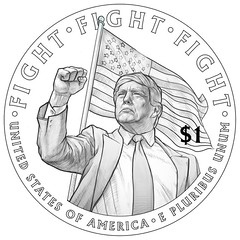 A proposed one dollar coin featuring US President Donald Trump is causing ructions across the political divide. It's also provoking discussion in the world of ancient Roman numismatics (coin studies).
A proposed one dollar coin featuring US President Donald Trump is causing ructions across the political divide. It's also provoking discussion in the world of ancient Roman numismatics (coin studies).
While only a draft proposal, the coin could be minted in 2026 to mark 250 years since the US declaration of independence. But an old law prohibits the "likeness of any living person" from being "placed upon any of the bonds, securities, notes, fractional or postal currency of the United States."
More than 2,000 years ago, the depiction of living figures on Roman coins caused similar ructions.
It came at a time when the Roman republic was in trouble. The republic would crumble altogether soon after, ushering in the long period of Rome being led by emperor-kings who saw themselves as almost akin to gods.
In 88 BCE, while consul, Sulla marched an army on Rome to defend the city from "tyrants" (by which he meant the faction of Marius, who had ousted him). After Sulla won the civil war that followed, he held the dictatorship from 82-79 BCE. Dictatorships were only to be held for six months in times of emergency. Sulla claimed the emergency was ongoing.
As part of this he ordered a list (known as proscriptions) of enemies drawn up. Hundreds or even thousands were killed and had property confiscated.
In the same year a silver coin (called a denarius) was minted in Sulla's name. One side featured Sulla himself riding in a four-horse chariot.
This was the first time a living person was depicted on a Roman coin. Up to this point only gods and mythological figures had that honour.
It was highly unusual.
Sulla was the first but he wouldn't be the last leader of the Roman republic to have his image on a coin.
Some emphasise that Caesar did not directly order his image to be placed on coins. Those wanting to curry favour read the room and Caesar did not object.
A similar scenario appears to be playing out with the coin design bearing Trump's image.
To read the complete article, see:
Trump on a coin? When Julius Caesar tried that, the Roman republic crumbled soon after
(https://theconversation.com/trump-on-a-coin-when-julius-caesar-tried-that-the-roman-republic-crumbled-soon-after-266887)
WOULD THE 2026 TRUMP COIN BE LEGAL?
Len Augsburger and others passed along this New York Times article about the legality of plans to picture President Trump on a semiquincentennial commemorative coin. Thanks. -Editor
The Trump administration on Monday defended its plan to mint a $1 coin bearing the image of President Trump despite the fact that an 1866 law dictates that only the deceased can appear on U.S. currency.
Initial designs for the coins released by the U.S. treasurer last week stirred controversy and accusations that the Trump administration was violating the law so that Mr. Trump could honor himself by putting his face on a coin. The 1866 law enshrined a tradition that individuals could appear on U.S. currency only posthumously to avoid the appearance that America was a monarchy.
But in a post on Monday, the Treasury Department said that featuring Mr. Trump on a coin in celebration of the nation's 250th birthday was authorized under the Circulating Collectible Coin Redesign Act of 2020.
The 2020 law does appear to put restrictions on images of the "tails" side of new coins. It states that "no head and shoulders portrait or bust of any person, living or dead, and no portrait of a living person may be included in the design on the reverse of specified coins."
The initial restriction on featuring the living on currency came in 1866. An explanation of the legislation on an archived page from the Treasury's website noted that the act "was caused by an uproar over the actions of the chief of the Bureau of Engraving and Printing, Spencer Clark," who had "placed himself on a five-cent note and had a large quantity of them printed before it was noticed."
To read the complete article, see:
Treasury Defends Lawfulness of Minting a $1 Trump Coin
(https://www.nytimes.com/2025/10/06/us/politics/treasury-trump-coin.html)
See earlier articles with examples of coins featuring Presidents, Senators, Governors and other public figures who were alive at the time of their issuance. There is precedent. And like everything involving laws, decisions often come down to individual words and their meaning (and who is interpreting their meaning). This Politifact article concludes that "Although the concept of a Trump coin runs counter to a longstanding tradition, there are no unscalable legal obstacles to establishing a U.S. coin with Trump's image on it." -Editor
Multiple pieces of coinage legislation enacted over the past few decades have included specific language prohibiting living people from being portrayed on U.S.-minted coins. In one case — a series of coins launched in 2007 honoring every president — the law's text goes further to specify that no coin in the series may "bear the image of a living former or current president, or of any deceased former president during the 2-year period following the date of the death of that president."
That barrier on living presidents was specific to that particular presidential coinage series, however — not to the series that would include the proposed Trump coin.
The guidance governing the series the Trump administration is considering comes from legislation authorizing a series of coins for the nation's 250th anniversary, known as the Circulating Collectible Coin Redesign Act of 2020. Trump signed the measure into law in January 2021, during his first presidency, following unanimous passage by both chambers of Congress. It authorizes the redesigns of quarters, half dollars and $1 coins in several sequential series, one of which is a 250th anniversary series to be launched in 2026.
The law for the 250th series refers specifically to the reverse of the coin: "No head and shoulders portrait or bust of any person, living or dead, and no portrait of a living person may be included in the design on the reverse of any coin" in the series. But it doesn't rule out a portrait on the front of the coin.
That may not be a high bar for Trump to jump if he wants to mint a coin with his image on it.
Unless Congress acts, the process from here would involve only administration officials, meaning the president could maintain direct control. Even if the courts were inclined to block the proposal, experts said it's uncertain whether anyone would be able to cite a direct harm from producing a Trump coin — a requirement for filing a lawsuit.
"It's unclear who would have standing to sue here," said Gabriel Mathy, an associate professor economics at American University who has studied coinage issues.
During the Civil War, Spencer Clark, an official with the federal office responsible for printing paper money, put his own image on a five-cent note. He did it by leveraging a legal loophole: Congress had approved a note featuring an image of William Clark, the explorer from the Lewis & Clark expedition of the Louisiana Territory, but lawmakers neglected to specify William Clark's first name in the legislation, journalist Blake Stilwell wrote in Military.com. So Spencer Clark, having the same surname, inserted his own image instead of William Clark's. Clark also produced a separate note that featured then-U.S. Treasurer Francis E. Spinner.
So in 1866, Congress passed a law saying no portrait or likeness of a living person would appear on "bonds, securities, notes, fractional or postal currency of the United States."
 The law doesn't mention coins, however. Living figures — and even one living president, Calvin Coolidge — have occasionally been featured on coins, including some in recent years.
The law doesn't mention coins, however. Living figures — and even one living president, Calvin Coolidge — have occasionally been featured on coins, including some in recent years.
To read the complete article, see:
Can Donald Trump legally put his image on a U.S. Mint coin? Probably
(https://www.politifact.com/article/2025/oct/07/trump-coin-mint-commemorative-dollar-legal/)
To read the earlier E-Sylum article, see:
TRUMP COMMEMORATIVE COIN PROPOSED
(https://www.coinbooks.org/v28/esylum_v28n40a25.html)
PHILIPPINE ABACA FIBER FOR CURRENCY?
The Philippine Fiber Industry Development Authority is lobbying for the use of abaca fiber in currency manufacturing. -Editor
 The Department of Agriculture (DA)'s fiber industry development arm is exploring the use of local abaca in banknote production with French authorities, promoting its use as part of a broader effort to strengthen the country's fiber industry and expand international market opportunities.
The Department of Agriculture (DA)'s fiber industry development arm is exploring the use of local abaca in banknote production with French authorities, promoting its use as part of a broader effort to strengthen the country's fiber industry and expand international market opportunities.
The Philippine Fiber Industry Development Authority (PhilFIDA) yesterday said they held a meeting with Banque de France, the national bank of France, and officials from the French embassy to discuss the potential application of abaca in currency manufacturing.
PhilFIDA executive director Ali Atienza led the discussions with representatives from France, including Pierre-Yves Boissinot of the Banque de France, Michael Barret, a research and development manager and Matisse Gauthier from the French embassy.
"Abaca is a world-class fiber that combines durability and eco-friendliness," Atienza said in a statement.
"By exploring its applications in currency production, we aim to showcase Philippine products on the global stage while promoting economic and cultural value," he added.
Abaca, also known as Manila hemp, is a biodegradable, renewable and highly durable fiber.
The Philippines supplies roughly 85 percent of the world's abaca according to the PhilFDA, making it a vital contributor to the global fiber market.
To read the complete article, see:
Philippine eyeing abaca for overseas banknote production
(https://www.philstar.com/business/2025/09/20/2474031/philippine-eyeing-abaca-overseas-banknote-production)
THE 2025 GOLD RUSH
With echoes of the 1980's silver boom, the Wall Street Journal published an article about the 2025 gold rush as seen through Manhattan's Diamond District. Here's an excerpt - see the complete article online. -Editor
 So many customers flocked to a New York City gold dealer this past week that staff had to ask people to wait outside.
So many customers flocked to a New York City gold dealer this past week that staff had to ask people to wait outside.
"I'll go through this all day long," said Chief Executive Ben Tseytlin, about the people piling into his shop, Bullion Exchanges. Some were there to sell gold, but increasingly people are coming to buy, he said.
It is one of several jewelry dealers along a stretch of Manhattan known as the Diamond District, where business has been thriving as gold and silver values rise. That has brought a flood of new faces to the crowded Midtown block that holds roughly 2,600 businesses, many owned by members of New York's Orthodox Jewish community. Vendors hang out on the sidewalks to try to grab customers.
"Selling gold?" is the common cry of the street.
"Over here, buddy," said a vendor as he flashed a business card.
At Diamond District Gold Buyers, owner Sandro Ragovski said he has had trouble keeping enough cash in the store to pay out people unloading their gold. He sometimes pays them partly by check. Recently, he had to walk to the bank with a seller who wanted a certified one.
"Cash runs out," he said.
Gold futures settled Wednesday at a record $4,043.30 a troy ounce, the special unit of weight used for precious metals such as gold, silver and platinum that dates to medieval trade markets. A day earlier, the precious metal surpassed $4,000 a troy ounce, a sign investors are rushing to alternative assets in the midst of concern regarding the U.S. economy. On Thursday, prices retreated from records, ending a four-session streak of gains, though futures remained near $4,000.
Bullion has flourished in recent months, boosted by worries about the outlook for inflation and the prospects for major currencies. Those includes the dollar, which has been weakened by concern about President Trump's upending of the postwar economic order. Geopolitical tension, including the Russia-Ukraine war, are bullish for gold.
Tseytlin spent most of the summer tending to customers who—spurred by gold's historic run—wanted to turn family heirlooms or coins into cash. More recently, those sellers have turned into buyers, he said.
"That's not a normal thing," Tseytlin said. He attributes the boom in bullion buyers to worry about the economy. People are buying gold coins and bars to stash, he said. His storefront is lined with various gold coins—including Krugerrands from South Africa—and 20-ounce bars of silver. There are gold coins wrapped in Diwali packaging for the coming Hindu holiday, and others from places like Canada and Switzerland.
To read the complete article (subscription required), see:
The Gold Rush in Manhattan's Diamond District
(https://www.wsj.com/finance/commodities-futures/the-gold-rush-in-manhattans-diamond-district-b5cb8671)
PAUL KRUGER'S NUMISMATIC LEGACY
On a related note, here's an article about the numismatic legacy of Paul Kruger of Krugerrand fame. -Editor
The year 2025 marks the bicentenary of the birth of Paul Kruger, a seminal figure in South African history whose legacy continues to resonate across political, cultural, and numismatic spheres.
Kruger's enduring presence in coinage has elevated him to global prominence within the field of numismatics.
According to Landon Coleske, numismatic expert and historian at Bassani's Auction House, "Paul Kruger would rank in the top 20 of people who have appeared on the most coins in history. Also, if you exclude monarchs, he'd be in the Top 5." This distinction underscores the remarkable extent to which Kruger's image has been embedded in South Africa's monetary heritage.
Kruger served as President of the South African Republic (ZAR). His leadership coincided with the introduction of South Africa's first national coinage, a development that would define the country's numismatic trajectory for generations. "A numismatic legacy that would define the country's coin history for over a century," Coleske says.
In 1892, Kruger's portrait was officially introduced on the ZAR coin series, which included the bronze penny, silver denominations ranging from threepence to crown, and the gold half-pond and pond coins.
These coins were distinguished by their meticulous design, featuring Kruger's profile on the obverse and the ZAR coat of arms on the reverse. "They represented not only a new currency but a statement of sovereignty and craftsmanship. Today, these early Kruger coins, particularly high-grade gold issues, are among the most valuable collectibles in the world, often commanding record prices at auction," Coleske says.
Among the most notable of these is the 1898 Single 9 Kruger Pond, minted in 1899 during the Anglo-Boer War as an emergency issue. "Only one single example was ever produced. The coin's crude ‘9' stamp, added to signify the new year, makes it utterly unique. More than a century later, it remains South Africa's most famous and valuable coin, recently (in January 2025) selling for R41 million, the highest price ever achieved for a South African coin," says Dillon Bassani, chief executive officer at Bassani's Auction House.
Kruger's numismatic legacy continued well beyond the dissolution of the ZAR. In 1967, his portrait was reintroduced on the Krugerrand, a pioneering bullion coin that transformed the global gold market. "The Krugerrand was the world's first modern bullion coin, created to make gold ownership simple and internationally tradable," says Coleske. Since its inception, over 60 million gold Krugerrands have been minted, making it the most recognised gold coin worldwide. In 2017, the range expanded to include silver Krugerrands, further entrenching Kruger's image in contemporary coinage. "Its success was extraordinary," Coleske says.
To read the complete article, see:
Paul Kruger: 200 years of a numismatic legacy
(https://persfin.co.za/personal-finance/financial-planning/2025-10-09-paul-kruger-200-years-of-a-numismatic-legacy/)
To read the earlier E-Sylum article, see:
THE SOUTH AFRICAN 1898 POND SINGLE 9
(https://www.coinbooks.org/esylum_v13n20a35.html)
LOOSE CHANGE: OCTOBER 12, 2025
Here are some additional items in the media this week that may be of interest. -Editor
A Greyheet article by Michael Garofalo examines Robert Scot's Draped Bust Half Cents. Here's an excerpt - see the complete article online. -Editor
After the American Revolutionary War had ended, the new fledgling government didn't have an army, a navy, or even its own money to spend. The Coinage Act of 1792 established that the United States should create its own minting facility and to create America's own coinage.
When the Philadelphia Mint opened for business in 1793, it first struck copper coins—Half Cents and Large Cents. Coinage in America at that time was a hodgepodge of foreign coins, each with its own unique value, so buying food priced in British Pounds with Dutch Guilders became a complicated transaction. Standardized American coins would make commerce much easier to conduct.
In 1793, the Mint struck only 35,534 Half Cents, all of which bore the Liberty Cap and Pole obverse with a Wreath reverse. All of these coins were designed by the first Chief Engraver of the United States Mint, Robert Scot. He was a Scottish-American engraver who was born in 1745 in Cannongate, Scotland. He moved to Fredericksburg, Virgina in 1775 and he changed the spelling of his last name from 'Scott' to 'Scot,' to make himself seem more American. One of his earliest jobs in America was engraving plates for Virginia's colonial banknotes. Ironically, the banknotes he engraved were adorned with the Coat of Arms of Great Britain. But a year later, as the Colonies declared their independence, the British Coat of Arms was replaced with a new design representing the Commonwealth of Virginia.
To read the complete article, see:
Engraving a Nation: How Robert Scot's Draped Bust Design Defined America's Coinage
(https://www.greysheet.com/news/story/engraving-a-nation-how-robert-scots-draped-bust-design-defined-americas-coinage)
Noonan's recently sold a group of medals belonging to a woman who perished on the Lusitania. -Editor
Anna Endresen died when the SS Lusitania was torpedoed and sunk off Old Head, Kinsale, on May 7 1915.
Originally from Norway, Endresen was a professional in the British Mercantile Marine. She served as matron in the Steward's Department on the Lusitania's final voyage.
Anything associated with the Lusitania is of interest to collectors, and this group of medals is especially rare because they were awarded to a woman.
On July 16, Endresen's British war medal 1914-20, Mercantile Marine war medal 1914-18, and memorial plaque: ‘She Died For Freedom and Honour' sold for £11,000 (€12,644) at Noonan's in London.
While we're all aware of the famous Karl Goetz medal on the sinking of the ship, the article notes that "British propagandists leapt on the opportunity to use the medal in a counter-propaganda campaign. Thousands of copies of the medal were produced by the British government and sold in Selfridges for one shilling each, with proceeds going to the British war effort."
I wasn't familiar with the British copies - how are they differentiated from the Goetz originals? -Editor
To read the complete article, see:
Shipshape memorabilia from tragic SS Lusitania, including rare medal collection, attracts interest at auction
(https://www.independent.ie/life/home-garden/shipshape-memorabilia-from-tragic-ss-lusitania-including-rare-medal-collection-attracts-interest-at-auction/a2104960419.html)
Dick Hanscom passed along this Daily Mail article about "ancient artifacts found on sale for $22 at Canadian thrift store." Thanks. -Editor
A set of ancient artifacts were discovered on sale for just $22 at a Canadian thrift store.
The set of precious rings and medallions were spotted by a shopper at Thrifty Boutique, a charity thrift store in Chilliwack, around 60 miles from Vancouver.
The customer had a background in archeology and alerted the store's volunteers who brought in experts from Simon Fraser University.
Eleven rings and two medallions were handed over which are believed to date back to medieval or Roman times.
The exact age and value of the artifacts is still under study, but it is suspected they are worth well above the $30 CAD OR $21.50 USD they were listed for.
'This is an incredibly exciting donation and an amazing opportunity for students here at SFU,' Sabrina Higgins, an associate professor in global humanities and archeology, said.
The jewelry has been placed in the care of SFU's Museum of Archeology and Ethnology and is set to become apart of the student's curriculum.
To read the complete article, see:
Incredible ancient artifacts found on sale for $22 at Canadian thrift store
(https://www.dailymail.co.uk/news/article-15177195/ancient-artifacts-sale-canada-thrift-store.html)
ABOUT THIS ISSUE: OCTOBER 12, 2025
Let's see, where did the week go? No races, but being off work with nice weather gave me a chance to get in a lot of walking. I won't need to upgrade my pedometer to have another digit, but it's getting a workout. I went a little farther each day, even making my way over to the W&OD Trail - "the skinniest park in Virginia." It's a 45-mile trail along the former roadbed of the Washington & Old Dominion Railroad.
Being off work has felt like a nice dry run for retirement, at least until my boss called Thursday and told me I'm being called back in next week from the government shutdown furlough. I won't get paid until *checks notes* maybe this is over, so that part's still like retirement. Or being Editor Emeritus, which Redbook Editor Emeritus Ken Bressett described as being, "you work anyway but don't get paid anymore."
Friday morning brought this retirement news:
"You'll never retire: A government panel in Germany has proposed raising the country's retirement age to 73 to prevent the collapse of their pension system. I'm a workaholic but even to me, making 73-year-olds keep working full-time seems insane. Think how long it would take them to open their emails every morning at that age?"
Opening emails is a lot of what I do in my editor's role. At first I thought an email about the "Treasures of the Occult" book was spam, but no, it was from Baldwin's and announced a legit numismatic book that sounds perfect for us E-Sylum coin freaks and weirdos. Check it out elsewhere in this issue.
Finally, here are some interesting non-numismatic articles I came across this week.
A volcanic eruption indirectly led to the invention of the bicycle.
(https://historyfacts.com/science-industry/fact/volcanic-eruption-bicycle-invention/?lctg=fc99d453-51bd-454f-b10d-ed4d7ce03f91)
David Foster Wallace Tried to Warn Us About these Eight Things
(https://www.honest-broker.com/p/david-foster-wallace-tried-to-warn)
What it looks like in the world's data center capital
(https://www.washingtonpost.com/opinions/interactive/2025/data-centers-artificial-intelligence-virginia-photos/)
-Editor
Wayne Homren
Wayne Homren is the founding editor of The E-Sylum and a consultant for the Newman Numismatic Portal. His collecting interests at various times included U.S. Encased Postage Stamps, merchant counterstamps, Pittsburgh Obsolete paper money, Civil War tokens and scrip, Carnegie Hero Medals, charge coins and numismatic literature. He also collects and has given presentations on the work of Money Artist J.S.G. Boggs. In the non-numismatic world he's worked in artificial intelligence, data science, and as a Program Manager for the U.S. Department of Defense.
Garrett Ziss
Garrett Ziss is a numismatic collector and researcher, with a focus on American paper money and early U.S. silver and copper coins. He is also a part-time U.S. coin cataloger for Heritage Auctions. Garrett assists Editor Wayne Homren by editing and formatting a selection of articles and images each week. When he's not engaged in numismatics, Garrett is pursuing a Master's Degree in Quantitative Economics at the University of Pittsburgh.
Pete Smith
Numismatic researcher and author Pete Smith of Minnesota has written about early American coppers, Vermont coinage, numismatic literature, tokens and medals, the history of the U.S. Mint and much more. Author of American Numismatic Biographies, he contributes original articles to The E-Sylum often highlighting interesting figures in American numismatic history.
Greg Bennick
Greg Bennick (www.gregbennick.com) is a keynote speaker and long time coin collector with a focus on major mint error coins and US counterstamps. He is on the board of both CONECA and TAMS and enjoys having in-depth conversations with prominent numismatists from all areas of the hobby. Have ideas for other interviewees? Contact him anytime on the web or via instagram
@minterrors.
John Nebel
Numismatist, photographer, and ANS Board member and Fellow John Nebel of Boulder, CO helped the ANA and other clubs like NBS get online in the early days of the internet, hosting websites gratis through his Computer Systems Design Co. To this day he hosts some 50 ANA member club sites along with our
coinbooks.org site, making the club and our E-Sylum archive available to collectors and researchers worldwide.
Bruce Perdue
Encased coinage collector (encasedcoins.info) Bruce Perdue of Aurora, Illinois has been the volunteer NBS webmaster from its early days and works each week to add the latest E-Sylum issue to our archive and send out the email announcement.

